#this highly deviated from the original intent of this post
Explore tagged Tumblr posts
Text
I feel like the norths and souths, as in North or South Dakota and Carolina, would get along pretty well with their counterparts. Like South Carolina would definitely invite South Dakota over for sweet tea after attending his bike rally and they both would complain about their siblings up north - who I feel wouldn't talk to each other as much but would also do the same about them - whenever they do meet - over puppy chow and barbeque (east or west based on what North Carolina gets then). They also have an added advantage of being able to say "There's a monster below me". They all still love each other though of course.
#the reason I think the norths wouldn't meet much is because I also think North Dakota tends to be pretty quiet in the videos#like he barely ever speaks from what I've seen#and most of the time it's either to ask a question because he's confused or in relation to South Dakota#I just feel like he doesn't talk much#Kind of like Alaska except he doesn't even bother to show up#I guess he prefers staying home too#he does get along with North Carolina the same way the souths are close to each other#but they just don't hang out as frequently as South Dakota and South Carolina do#also I only noticed this while writing the last lines#the souths come in the videos a lot more than the norths#guess NC prefers staying home too#this highly deviated from the original intent of this post#anyways#welcome to the table#welcome to the statehouse#wttt#wttsh#wttt north carolina#wttt north dakota#wttt south carolina#wttt south dakota
38 notes
·
View notes
Text
For what it's worth, I mostly still stand by everything under my old tags (Jaune/Cinder, Cinder's redemption, V10 predictions - although there's a few I drafted out in addition to whatever I did post on here), according to reading RWBY-the-show. I still maintain most of what we've seen was intended in one way or another (Ozlem, I/ronwood, the redemptions we've seen already, Jungian/alchemical based storytelling) since they're very early products of the show, even down to finer details like foreshadowing a future Ruby/Ozma reincarnation partner (V1/2 hints). The question is whether that proves true in whatever form the show survives in at this point because there are creative compromises which happen because of that.
Very clear elements of V9 suggest this was already beginning to happen (see: tonal abruptness from V8->V9, only picking up again at the halfway point e.g. when viewer drops always happen, which was where a twist was saved for) and I'd go so far as to contend what makes the pacing of E1-4 feel odd, but for some elements which seem highly suggestive of expected Jungian beats (visions of oneself in the caterpillar hut), is because it was specifically to draw in an audience which enjoyed Beacon hijinks but also newer viewers who want familiar tropey hijinks (and I think it is telling that beats of the volume especially compromised was the ending). And it didn't work. Then past that roadbump there's a tonal shift to something more familiar: serious narrative stakes and emotional journeys. And like, a suggestion of fraughtness.
This is a classic stunt of the average aggrieved RWBY fan, for the record. As far back as Volume 1 fans were complaining the show was 'deviating from the vision'. I remember it very clearly. Headcanons had already shaped around the character trailers. By V2 there were people unhappy with rushed production and animation errors and not enough of xyz trope and then there had been too much Jaune in the previous volume, so that was an endless fandom debate.
At a certain point with creative compromise it's no longer about compromise and more about what the creators are willing to let a work be, and that's just what it is: no crying for original intent, and instead time to come to terms with what it truly is. So I am never willing to pull the 'if only RWBY had not become creatively compromised' excuse, but I am hoping against hope that missteps in V9 were simply that - missteps - and if the show gets renewed, it's not on those terms, because they didn't work anyway to get it renewed. And I remember writing an unpopular post that the ongoing lampshading in the volume, and the clumsiness of the twee character writing was a clear, fatal compromise which was never going to win halfway fans over and was only going to alienate weirdoes like me. But then if the show happens to be renewed, and it reprises these elements, that - say - they want to cater to xyz fan demographic or they want to go back on the show which had been set up and had been realised across subsequent volumes - then I would admit defeat.
But then I don't know the ins and outs of the business side of the production anymore, and I think I am still in fantasyland where RWBY gets to be an independent production. So who really knows. I still think most of what I had to say on the topic of conceivable Jaune/Cinder was coherent, but in terms of alienating the fanbase, that ship is about as bad as you can get. Where their priorities are in renewal, if it happens, is uncertain. But then why renew RWBY if you can't do RWBY? Lol. But then, was Knightfall ever RWBY? I would like to know at least!
1 note
·
View note
Text
The Original Intent of Terra and how Deathstroke got the bad end of the stick for it
Okay, Deathstroke Children (Idk what to call you guys because fellow Deathstrokers would end this conversation immediately), I found the time to do this, so let's get to it!
(Note: My original laptop broke with my comics, so I have no images to spare, so it will be sourced. Another note: Many words will be in bold. Partly so that for those reading will not lose track.)
But if tl;dr:
Cold Hard Truth: Everyone from Terra fans to Deathstroke fans needs to stop seeing these characters as real people.
Original Terra wasn't human trafficked or whatever sob story people want to label her with. The CREATORS intended her to be written as Evil without the mental illness and to die for the shock value. They had Raven, The Literal Empath, spell this out in Judas Contract. As for Deathstroke's involvement, he was shoved into her creation story, and Marv Wolfman himself recognized his mistake in doing that.
And for those calling Deathstroke a nazi, Original Terra had nazi-like beliefs where common people should fear and serve them or be killed off just because they're 'special'. Again, BLUNTLY stated in the Judas Contract. So if you're going to call Deathstroke a Pedophile, we'll call OG Terra a Neo-Nazi. (But I highly advice for Deathstroke Fans to not start that kind of war, but I had to say what I had to say.)
Don't get me wrong. (Hopefully all) Deathstroke fans know that their relationship was wrong just like Marv Wolfman, and we do not support pedophiles! But Slade isn't a pedophile! He was never intended to be written as one! It was a mistake made on many levels and should be rewritten like OG Terra's Evil Neo-Nazi-like personality, instead of being thrown into cancel culture.
Also for Deathstroke fans, don't get upset over their content and begin any argument emotionally. Just enjoy whatever good content we can get and support it if you can. Hopefully we'll get our Deathstroke movies and so on!
So I've briefly chatted with one of you over the matter with Terra/Tara Markov and how upsetting it is about how people refer to Slade Wilson as a Pedophile. That is a serious accusation that would make it very uncomfortable to argue about since it can easily make it seem like we justify the actions of pedophiles, and that we are part of pedophile culture that does exist in social media space.
AND WE SHOULDN'T, AND FOR ANTIS READING THIS WE WON'T.
But there was a time when I used to have a blog called friendlyremindersofsladewilson, where I defended Slade and put the blame all on Terra. I was 14 at the time, and looking back at it, I am not proud of it because I realized now as an adult how I defended it for most of the wrong reasons, but still stand with the fact that SLADE IS NOT A PEDOPHILE.
And since this took place when I was so young, it compelled me to write this post because I fear some of you are really young, too, and may end up in this regretful position.
So to make it clear, what Slade had been written to do is a crime, and we should acknowledge it, but not in the way as if it was a crime acted out in real life.
What I mean by that is that there's a clear separation between fiction and reality where one isn't real (Duh!). In this case, it's about the mistakes made between fiction and reality. In reality, mistakes made by the person responsible is on the person. In fiction, mistakes made is dependent on the creator's intent, and sometimes the creators can make mistakes themselves.
Most notably Terra's:
Tara Markov/Terra was created by Marv Wolfman and George Perez.
In Marv Wolfman's literal website, he stated in his online "What the-?" column:
"Which leads to Terra. That was easy. George and I wanted a Titan who betrayed the others. we also wanted to play against every reader conception of who characters are. George and I knew her whole story before we began and we knew she would die. We set the story up with her trying to destroy the Statue of Liberty to show she was the bad girl, but we knew if George drew her as a cute kid everyone would simply assume she would be ‘turned’ from the dark side because that’s the way it was always done which is why that wouldn’t be the way we did it. Tara was insane an stayed that way right until the moment she died. By the way, she IS dead. I don’t know what other writers will do with her – if anything – but if they want to honor the original series they will leave her dead. The Terra from Team Titans was – as stated – some kid the villain kidnapped and physically and mentally altered her into looking and acting like the original. But she was NEVER the real Terra."
And it should also be noted that he stated before this statement that:
"...Only mistake I think I made with him is having him have a physical relationship with the 16 year old Tara Markov. That was wrong."
So Marv Wolfman himself recognizes that what he did was a mistake, but his intent on Terra was never to write a victim.
And quick note: Insanity isn't written as a mental illness here. It's written like how many villains are labeled as insane for having skewed beliefs that deviates from the common good.
Terra truly had some nazi-like beliefs where she BELIEVED that everyone who wasn't 'special' like her and the Teen Titans deserved to be treated like shit because they weren't 'special' like them. She bluntly said it herself in the Judas Contract.
As for George Perez's comment in an interview I found in this website:
"GEORGE: Tara was just a cute little girl, although I based a little bit of that on my wife Carol’s sister, Barbara. A little upturned nose… Barbara does not have the teeth that Tara had. I wanted Tara to be a girl who looked normal. Which also means her death caught everyone even more offguard.
Tara, she was made to be killed; she served her purpose. That was it.
ANDY: You didn ‘t get any attachment to Tara?
GEORGE: No, because I knew we were going to kill her. So I deliberately used all the things to make her as likeable and cute as possible, so people would never believe we were going to kill a sixteen-year-old. And she was a sixteen-year-old sociopath. She was one of our cleverest gimmicks; we deliberately created her in order to lead everyone astray. So we couldn’t build any fondness for her, ’cause we knew full well what her whole motive for existence was. Her existence was basically to keep the stories interesting; we were tossing a curve that no one would have expected.
ANDY: You didn ‘t even love to hate her, huh?
GEORGE: No. I loved handling her, because she was such a good idea. But she was an idea. Not as much a person. She was there to show exactly how much their humanity can be one thing they have to be careful about, the Teen Titans have to be careful about. . . they can be too trusting, or their own weaknesses can be used against them."
Terra was supposed to be a representation of An Evil Betrayal of Trust and That Not All Cute Girls Are Good.
But they took it too far by making her sleep with Deathstroke because they wanted to truly make her look evil by literally sleeping with the enemy. Y'know because this was the 80s, and women having sex was an evil act back then, and that point of view has somewhat or barely improved 40 years later.
Deathstroke was just shoved into this idea, and Marv tried and perhaps failed at trying to undo this mistake with his talk with Beastboy (Tales of the Teen Titans issue #55) and before his confrontation from Wintergreen (Deathstroke (1991); Chapter 35).
So just as I had stated at the top in the tl;dr, it was a mistake made on many levels and should have been rewritten out just as many had done with OG Terra's true personality, and be done with it.
Random person: "He still slept with a 16-year-old."
And it's not that hard to make other heroes and villains do this mistake. Because again, it's all fiction. Deathstroke's fictional. As in Not Real, so we could literally undo the damage by rewriting this mistake. Or make it worse by making Terra the rapist by her using her Earth powers to bind Slade down and force him, and you can't deny that it's plausible. Because she's fictional. Anything can happen. So why didn't Slade tell Beastboy whether he slept with her or not, maybe it was because he really didn't want to but he was forced into it. And that's just something you can't dump on a very emotional man who was trying to kill you a moment ago.
ALL THE POSSIBILITIES BECAUSE IT'S FICITIONAL!
But ANYWAY, I went way too dark there.
Ending on a brighter note: Personally to all Deathstroke fans, please value your mental health, please don't start any arguments that'll compromise it, and continue supporting Deathstroke in whatever way you can!
87 notes
·
View notes
Text
Mickey and Ian - communication, sex, and relationship styles, post 11x07
Here’s my take on how Ian and Mickey relate to sexuality and relationship styles, thinking mainly about 11x07, but also looking more broadly at the series and including HoS. If you’re not interested in incorporating 11x07 in your version of canon, ignore this! I enjoyed 11x07 but I understand people have different ways of seeing Ian and Mickey’s relationship. I’m also doing the classic meta thing of taking seriously exaggerated/comic/contradictory elements in the show because that’s how I roll.
Super long post under cut.
I’ve been reading Sexuality: A Graphic Guide by Meg-John Barker and Jules Scheele which is where a lot of the following ideas and terminology come from. I’ve also been looking at Meg-John Barker’s free relationship zine on their website rewritingtherules.com. I highly recommend their work, including the podcast they have with Justin Hancock, The Meg-John and Justin podcast (although MJ has left now and it’s called Culture, Sex, Relationships, but you can check out the backlog!)
They think about sex and relationship styles using various models including monogamy/polyamory, allosexuality/asexuality, romance/aromance etc. They look at these different facets of sexuality/relationship styles as complicated continua rather than binaries which shift over time. They also write about sexuality on an action/identity spectrum, communication strategies around relationships styles, and the windows into relationships. Here, I’m looking at all of these things thinking about Ian and Mickey’s relationship and as individuals within the relationship.
The monogamy/polyamory continuum
I’ve seen a bit of debate about how to label Mickey and Ian’s relationship on the monogamy/polyamory spectrum and I think it’s a pretty complex question especially considering those labels mean different things to different people and that relationships shift a lot over time. While labels like these can be useful, they can also be rigid and restrictive in their own ways.
Some terms that come close-ish to what they say they’ve decided in 11x07 are monoamorous and polysexual, considering they aren’t at all interested in romantic connections outside of each other but are up for sex (in a broad sense) with other people. But these terms don’t account for the agreement that they’re only exploring sex with other people when they’re together.
As people have pointed out, some of the boundary setting around exactly how they’re involving other people in the relationship is left off-screen, and also they’re not necessarily going to form identities around how they act in one episode. I’ve also seen people suggest reading their relationship style as monagamish and/or that what they do with other people is part of kink/play. I think these make sense in different ways and that in 11x07 Ian and Mickey definitely focus more on what they do (action) rather than who they are (identity) in regards to monogamy/polyamory.
In 11x01, Ian’s focus is more on identity. He sets up a binary choice between being monagamous or not in their relationship. 11x07 indicates they’ve moved through off-screen discussion into a much more personalised arrangement with more focus on actions allowing for flexibility over time. In 11x07, we see them agree on rules: sex in a broad sense is allowed outside of the primary partnership, love isn’t. They keep negotiations ongoing (e.g. in the bedroom, in the furniture store), and there is an indication that these rules could change over time.
I’d love to read/explore more about the ways in which this approach has changed over the course of the whole show. At the start of their relationship, definitely prior to s4, they have much more implicit rules about who they can have sex with, and those implicit rules become problematic in s5, when they realise they’re not completely on the same page regarding them. They bring up clashing ideas around the rules when Mickey’s leaving prison in s10 too. In s11, their relationship becomes more intentional, with these rules stated aloud rather than assumed.
The action/identity continuum in regards to gay sexuality
On a slight tangent, I think there’s a comparison to be made here to how they relate to sexuality (specifically gender of attraction) and the idea of gay identity, which seems to develop in the other direction. For Mickey especially, for a long time having sex with men was something he did rather than something he was, and that’s gradually somewhat shifted over the course of the show. There’s so much more that can be explored here, for instance, about how the action-based approach is much more acceptable within the hyper-masculine environment he was raised. Terry also approaches it this way when talking about prison sex, for example. According to this very oppressive social script, having sex with men in certain circumstances can be OK but claiming that as part of who you are is absolutely not.
But I also want to stress, I don’t think either approach to gay sexuality, looking at it through actions or through identity, is inherently better or worse. These different lenses on sexuality also intersect with class and levels of education. As explored in Sexuality: A Graphic Guide, the identity approach is also relatively a very modern way of seeing sexuality (late 20th century). Gender of attraction is also only one facet of sexuality (which includes amount of sex you want, type of sex, sexual roles etc.) but its now often regarded as the only or most important facet of sexuality. The identity-based approach is much more acceptable within the more aspirational/middle class settings they interact with in s10 and s11. In these seasons, Mickey and to a lesser extent Ian aren’t completely willing to accept it wholesale. I like how, for example, even well after “coming out”, Mickey often still approaches sexuality through actions rather than identity, e.g. his response to the woman at the flower shop asking if he’s a homosexual: “He is, I just like having another man’s dick up my ass.”
However, I also think it’s cool/interesting how Ian and Mickey both move towards and embrace various parts of mainstream gay identity in s11 too, and a large part of that involves combatting the sexism, femmephobia, and hypermasculinity with which they were raised, e.g. of course, singing and dancing to Lady Gaga and Ariana Grande in the bathroom.
You could also look at the different ideas about the origins of their gay sexuality in HoS through this lens. Mickey goes for a psychological/behavioural approach (based in like early 20th century sexological theories); Ian goes for a born-this-way, biological/genetic approach (popularised in the 1980s as part of gay pride movements).
Mickey’s approach is very old school (definitely a way of thinking that reflects his upbringing), which assumes straight is the norm from which gay deviates, to do with Freudian theory/the idea of homosexuality as pathology. He doesn’t, for example, seek to use the same model (Fiona’s bad relationship history) to explain why Lip is straight. Ian’s approach (”not because I was born this way?”) reflects his investment in the intractability of sexuality related to his strict opposition to conversion therapy models and the idea of being gay as a choice. It also reflects the way he reacts negatively/disbelievingly to Debbie’s more flexible sexuality (in s8?). While obviously it’s fucked up/impossible to force people to change their sexuality and it’s perfectly reasonable for him to define the origins of his own sexuality however he wants, this approach risks excluding more fluid experiences of sexuality.
Again, Mickey’s approach is more behavioural/action oriented and Ian’s is more identity oriented. They both seem pretty willing to shift their ideas around this though (especially Mickey, who potentially is just regurgitating old stuff he’s heard without thinking). The concluding thought is that Ian is gay because he likes Mickey’s d, lol.
Individual differences on sex and relationship continua
I really like the detail that Ian doesn't want to have sex and be friends with anyone else aside from Mickey. In 11x07, he doesn't want to make friends with the guys in the locker room although he's down for repeat sexual experiences which suggests he thinks he forms romantic attachment through a combination of both sex and friendship. It seems like it's important to him in his negotiation with Mickey that they don't form romantic attachments outside of their own relationship.
This relates back to the 87% thing in HoS where Ian says he tends to get at least slightly attached to everyone he has sex with and Mickey has 87% of his heart. Mickey doesn’t like the 87% thing at all but I reckon it outlines a really interesting difference between the two characters in regards to relationship styles. It indicates that Ian is comfortable with a slightly less mononormative way of doing nurturance/care than Mickey, while Mickey seems to initiate more of the polysexuality than Ian in 11x07. (Although of course, we don’t see how Ian would react if Mickey were to tell him he’s got 87% of his heart! -- but this is a very difficult to imagine scenario).
Sex is a big part of their relationship for both of them. Both Ian and Mickey seem pretty allosexual (e.g. they feel sexual attraction for other people generally), but Mickey is possibly even more so than Ian. Mickey also maybe falls on the aromantic/grayromantic spectrum (once again, the labels can be really useful but I don’t want to be too prescriptive/rigid). Ian seems to be more alloromantic, with a capacity to experience romantic attraction to a whole bunch of people. For him, sex and romance seem to be more interconnected in all cases although he can definitely separate the two (especially when thinking about transactional sex etc).
But I think it's more complex than that. For instance, Mickey reserves certain sexual acts for just between him and Ian and its clear that they have both intimacy and exploration in their sex life. From the outset, Ian and Mickey’s relationship involves exploration and excitement with sex, and provides a freedom to explore their sexualities in regards to sexual roles and kink. It’s clear that Mickey values the safe space Ian specifically gives him in this regard from very early on in their relationship. There’s a parallel here with the bathroom Gaga/Grande scene where Ian’s instinct isn’t to tease or make fun of Mickey but support him embracing more stereotypical gay behaviours and/or more fluid gender roles to the ones he’s grown up with outside of sex too.
Also it might be useful to complicate the idea of romance itself which is a really difficult idea to pin down and which seems to mean different things for both of them. I love the stress on friendship in 11x07. Friendship and also family connection play such key parts in their relationship with one another and the way in which they are attached, arguably even more so than traditional models romance. Both HoS and the Hopper painting discussion are interesting to think about in regards to the ways Ian and Mickey think about the concept of romance differently and the ways it intersects with or differs from their ideas around friendship/family. I like how Mickey’s willing to see getting a coffee together as romantic in a positive way for instance after Ian explains that it’s about togetherness in hard times. While maybe Mickey sees Ian’s suggestion of having a bath together as awkward/weird because he views it more as trying to live up to a social script of what is “romantic”.
Communication strategies around relationship styles
In s11, Ian and Mickey’s relationship is very entwined, and, in comparison to Tami and Lip, for instance, they disclose a lot to each other. Ian asks that they tell each other everything, and although Mickey is more resistant to that initially, he becomes much more forthcoming with his feelings in s11 (around Terry, around moving to the West Side, around becoming a parent).
While I appreciate Ian’s role in initiating more communication between the two of them, I felt sorry for Mickey in their initial discussion in 11x01 in re “monogamous or not”. The turning over the paper method is a pretty binary way to open up a discussion about a very charged and complicated thing.
They do seem to complement each other in this regard though with Ian generally more keen to initiate conversation but also getting more trapped into binaries, narratives of normativity and should-stories. While Mickey totally still projects an image that is informed by local expectations around masculinity and white supremacy, he’s also a rule-breaker in many ways and doesn’t have the same desire to conform to what society perceives to be “normal” (thanks HoS), especially behind closed doors and within his relationship with Ian (“liking what I like don’t make me a bitch”). @fiona-fififi had a really good point in the tags a while back about how Mickey’s investment in their wedding and its success might have spurred Ian on further to embrace more normative ways of doing relationships. This is super interesting, and also makes me think just about how being married itself prompts Ian to think about taking a more active role in pushing the relationship further up the relationship escalator and in pushing for more communication around these steps in general.
There’s also something to be said about pressurising each other in 11x07, especially when they jokingly(?) threaten each other with sex with other men if both of them aren’t around. I doubt they were making these suggestions seriously but it definitely doesn’t strike me as the most consensual method of communication. But there’s parallels here with generally using sex as a bargaining chip earlier on in the season. Ian seems to do that after having exhausted his attempts at trying to have conversations around money/monogamy etc, as a tried and tested way of getting Mickey to engage with him. And it definitely reflects using sex with each other and sex/relationships with other people (e.g. s3 Angie/Ned, s10 Byron/Cole) as modes of communication in earlier seasons. It kind of makes sense that they still have these habits in s11 even if they are no longer the primary mode of communication.
Ian and Mickey relied so much on implicit communication in the early seasons and they have highly developed nonverbal ways of communicating. I don’t want to say that either verbal or nonverbal ways of communicating are inherently better than the other. They seem to understand each other on a deep level, which is really cool, but people have pointed out can make them think they don’t need to verbally communicate when they do, because they assume that they’ll understand one another and be on the same page. It’s super interesting to see them maintain that deep connection and continue to use nonverbal cues while also adopting more explicit and intentional communication styles in s10 and s11.
The windows of their relationship
The fandom is always bringing up how Ian and Mickey leave the doors open when they bang, lol, and also making fun of how much Ian overshares. I think this is v fair but it also strikes me as pretty healthy that he wants people to see into his and Mickey’s relationship, especially in his discussions with Lip. But Ian’s got plenty of people around him who can see and help when things get tough.
In s11, it’s great to see Mickey get closer to the Gallagher family and see various members defending him or taking his side in arguments, but he definitely does have less of an on-screen support system than Ian. (I wish that they had developed his and Sandy’s relationship in s11). I think the aftermath of the City Hall incident in s10 really reveals this particular imbalance in their relationship. On one level, Mickey moves in with Byron as a reaction to being hurt and even maybe a strategy of revenge/manipulation, on another, he doesn’t really have anywhere to go aside from the Gallagher house when/if he needs to get away from Ian. Also, the way he retreats back to the Gallagher house when he can’t deal with the Westside is an interesting development of this in s11.
Ian’s need to share stuff about their relationship is kind of exciting considering his history of being unforthcoming about his relationships (and his history of being in a lot of secret relationships), as well as how difficult he found it to talk about Mickey while Mickey was away. But there is a different problem with ongoing talk around privacy and boundaries here too (Mickey doesn’t want Ian to chat about how he’s not into rimming!). Although to be fair, Mickey also chats about a lot of explicit sex stuff with strangers.
Although they do ultimately decide against pursuing the pretty inorganic way of making friends in 11x07, Ian’s desire to make gay friends who he can talk to about relationship stuff makes sense in terms of the way he has been pushing for a more intentional relationship with more communication and more explicit discussion and compromise this season (and last season too). It also intersects with an idea of him/both of them going further to embrace gay sexuality as an identity.
It’s interesting that Mickey’s the one to initiate this decision through ribbing Ian about his relationship with Lip. Why’s Mickey doing that? Is it just to be a little shit or is he also trying (subconsciously?) to activate Ian in some direction? (And also, maybe there’s a parallel there to getting their apartment in the west side, where Mickey’s the one inadvertently introducing Ian to the idea by pushing for them to go play in the pool).
-----------
There’s a lot here which is just scratching the surface of thinking about Ian and Mickey’s relationship in the context of these different sexuality and relationship continua. For e.g. it would be really interesting to think more about this stuff in terms of shifting sex roles and kink exploration. Of course it’s all up for interpretation and I am sure I am highlighting areas that I’m personally interested in and inadvertently projecting myself/my own preferences and styles into this discussion. Very down for disagreements and discussions if other people are interested and manage to read all of this, lol.
#Ian x Mickey#Gallavich#shameless meta#shameless 11x07#sexuality#relationships#Meg-John Barker#shameless s11#Ian Gallagher#Mickey Milkovich#why did i write all of this?#Shameless HoS
62 notes
·
View notes
Text
Chicago at Long Beach, LA, 1992: A Story of Bebe Neuwirth, Choreography, Riots, Revivals, and Relevance
Recently and rather excitingly, more footage made its way to YouTube of the 1992 version of Chicago staged at Long Beach in LA, featuring Bebe Neuwirth as Velma and Juliet Prowse as Roxie.
Given its increased accessibility and visibility, this foregrounds the chance to talk about the show, explore some of its details, and look at the part it might have played as a contribution to the main ‘revival’ of Chicago in 1996 – which has given the show one of the most resonant and highly enduring legacies seen within the theatre ever.

This Civic Light Opera production at Long Beach was staged in 1992, four years before the ‘main’ revival made its appearance at Encores! or had its subsequent Broadway transfer, and it marked the first time a major revival of Chicago had been seen since the original 1975 show disappeared nearly 15 years previously.
This event is of particular significance given its position as the first step in the chain of events that make up part of this ‘new Chicago’ narrative and the resultant entire multiple-decade spanning impact of the show hereafter.
But for all of its pivotal status, it’s seldom discussed or remembered anywhere near as much as it should be.
This may be in part because of how little video or photographic record has remained in easily accessible form to date, and also because it only played for around two weeks in the first place. As such, it is a real treat on these occasions to get to see such incredible and unique material that would otherwise have been lost forever after such a brief existence some 30 years ago.
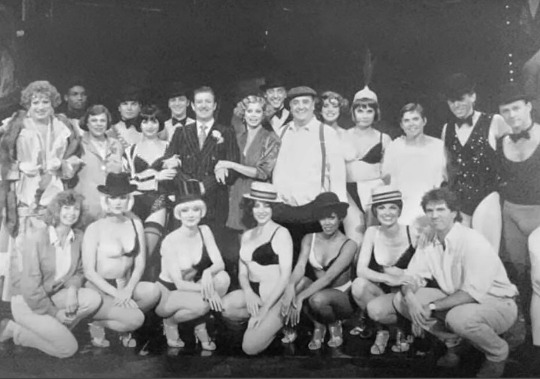
This earlier revival of the show still feels like what we have come to identify “Chicago” as in modern comprehension of the musical, most principally because the choreography was also done by Ann Reinking. As with the 1996 production, this meant dance was done “very much in the master’s style” – or Mr Bob Fosse.
The link below is time-stamped to Bebe and Juliet performing ‘Hot Honey Rag’. As one of the most infamous numbers in Broadway history, it’s undoubtedly a dance that has been watched many times over. But never before have I seen it done quite like this.
https://youtu.be/4HKkwtRE-II?t=2647
‘Hot Honey Rag’ was in fact formerly called ‘Keep It Hot’, and was devised by Fosse as “a compendium of all the steps he learned as a young man working in vaudeville and burlesque—the Shim Sham, the Black Bottom, the Joe Frisco, ‘snake hips,’ and cooch dancing”, making it into the “ultimate vaudeville dance act” for the ultimate finale number.
Ann would say about her choreographical style in relation to Fosse, “The parts where I really deviate is in adding this fugue quality to the numbers. For better or worse, my style is more complicated.” The ��complexity’ and distinctness she speaks of is certainly evident in some of the sections of this particular dance. There are seemingly about double the periodicity of taps in Bebe and Juliet’s Susie Q sequence alone. One simply has to watch in marvel not just at the impressive synchronicity and in-tandem forward motion, but now also at the impossibly fast feet. Other portions that notably differ from more familiar versions of the dance and thus catch the eye are the big-to-small motion contrast after the rising ‘snake hips’ section, and all of the successive goofy but impeccably precise snapshot sequence of arm movements and poses.
More focus is required on the differences and similarities of this 1992 production compared against the original or subsequent revival, given its status and importance as a bridging link between the two.
The costumes in 1975 were designed by Patricia Zipprodt (as referenced in my previous post on costume design), notably earning her a Tony Award nomination. In this 1992 production, some costumes were “duplications” of Zipprodt’s originals, and some new designs by Garland Riddle – who added a “saucy/sassy array” in the “typical Fosse dance lingerie” style. It is here we begin to see some of the more dark, slinkiness that has become so synonymous with “Chicago” as a concept in public perception.
The sets from the original were designed by Tony Walton – again, nominated for a Tony – and were reused with completeness here. This is important as it shows some of the original dance concepts in their original contexts, given that portions of the initial choreography were “inextricably linked to the original set designs.” This sentiment is evident in the final portion of ‘Cell Block Tango’, pictured and linked at the following time-stamp below, which employs the use of mobile frame-like, ladder structures as a scaffold for surrounding movements, and also a metaphor for the presence of jail cell bars.
https://youtu.be/4HKkwtRE-II?t=741
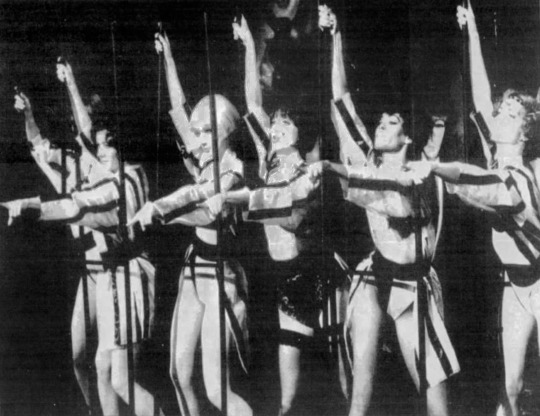
Defining exactly how much of the initial choreography was carried across is an ephemeral line. Numbers were deemed “virtually intact” in the main review published during the show’s run from the LA Times – or even further, “clones” of the originals. It is thought that the majority of numbers here exhibit greater similarity to the 1975 production than the 1996 revival, except for ‘Hot Honey Rag’ which is regarded as reasonably re-choreographed. But even so, comparing against remaining visible footage of Gwen Verdon and Chita Rivera from the original, or indeed alternatively against Bebe and Annie later in the revival, does not present an exact match to either.
This speaks to the adaptability and amorphousness of Fosse-dance within its broader lexicon. Fosse steps are part of a language that can be spoken with subtle variations in dialect. Even the same steps can appear slightly different when being used in differing contexts, by differing performers, in differing time periods.
It also speaks to some of the main conventions of musical theatre itself. Two main principles of the genre include its capacity for fluidity and its ability for the ‘same material’ to change and evolve over time; as well as the fact comparisons and comprehensions of shows across more permanent time spans are restricted by the availability of digital recordings of matter that is primarily intended to be singular and live.
Which versions of the same song do you want to look at when seeking comparisons?
Are you considering ‘Hot Honey Rag’ at a performance on the large stage at Radio City Music Hall at the Tony Awards in 1997? Or on a small stage for TV shows, like the Howard Cosell or Mike Douglas shows in 1975? Or on press reel footage from 1996 on the ‘normal’ stage context in a format that should be as close to a replica as possible of what was performed in person every night?
Bebe often remarks on and marvels at Ann’s capacity to travel across a stage. “If you want to know how to travel, follow Annie,” she says. This exhibits how one feature of a performance can be so salient and notable on its own, and yet so precariously dependent on the external features its constrained to – like scale.
Thus context can have a significant impact on how numbers are ultimately performed for these taped recordings and their subsequent impact on memory. Choreography must adjust accordingly – while still remaining within the same framework of the intention for the primary live performances.
This links to Ann’s own choreographical aptitude, in the amount of times it is referenced how she subtly adapted each new version of Chicago to tailor to individual performers’ specific merits and strengths as dancers.
Ann’s impact in shaping the indefinable definability of how Chicago is viewed, loved and remembered now is not to be understated.
An extensive 1998 profile – entitled “Chicago: Ann Reinking’s musical” – explores in part some of Ann’s approaches to creating and interacting with the material across a long time span more comprehensively. Speaking specifically to how she choreographed this 1992 production in isolation, Ann would say, “I knew that Bob’s point of view had to permeate the show, you couldn’t do it without honoring his style.” In an age without digital history at one’s fingertips, “I couldn’t remember the whole show. So I choreographed off the cuff and did my own thing. So you could say it was my take on his thoughts.” Using the same Fosse vocabulary, then – “it’s different. But it’s not different.��
One further facet that was directly carried across from the initial production were original cast members, like Barney Martin as returning as Amos, and Michael O'Haughey reprising his performance as Mary Sunshine. Kaye Ballard as Mama Morton and Gary Sandy as Billy Flynn joined Bebe and Juliet to make up the six principals in this new iteration of the show.
Bebe, Gary and Juliet can be seen below in a staged photo for the production at the theatre.

The venue responsible for staging this Civic Light Opera production was the Terrace Theatre in Long Beach in Los Angeles. Now defunct, this theatre and group in its 47 years of operation was credited as providing some of “the area’s most high profile classics”. Indeed, in roughly its final 10 years alone, it staged shows such as Hello Dolly!, Carousel, Wonderful Town (with Donna McKechnie), Gypsy, Sunday in the Park with George, La Cage aux Folles, Follies, 1776, Funny Girl, Bye Bye Birdie, Pal Joey, and Company. The production of Pal Joey saw a return appearance from Elaine Stritch, reprising her earlier performance as Melba Snyder with the memorable song ‘Zip’. This she had done notably some 40 years earlier in the original 1952 Broadway revival, while infamously and simultaneously signed as Ethel Merman’s understudy in Call Me Madam as she documented in Elaine Stritch at Liberty.
Juliet Prowse appeared as Phyllis in Follies in 1990, and Ann Reinking acted alongside Tommy Tune in Bye Bye Birdie in 1991, in successive preceding seasons before this Chicago was staged.
But for all of its commendable history, the theatre went out of business in 1996 just 4 years after this, citing bankruptcy. Competition provided in the local area by Andrew Lloyd Webber and his influx of staging’s of his British musicals was referenced as a contributing factor to the theatre group’s demise. This feat I suspect Bebe would have lamented or expressed remorse for, given some of her comments in previous years on Sir Lloyd Webber and the infiltration of shows from across the pond: “I had lost faith in Broadway because of what I call the scourge of the British musicals. They've dehumanized the stage [and] distanced the audience from the performers. I think 'Cats' is like Patient Zero of this dehumanization.”
That I recently learned that Cats itself can be rationalised in part as simply A Chorus Line with ears and tails I fear would not improve this assessment. In the late ‘70s when Mr Webber noticed an increase of dance ability across the general standard of British theatre performers, after elevated training and competition in response to A Chorus Line transferring to the West End, he wanted to find a way he could use this to an advantage in a format that was reliable to work. Thus another similarly individual, sequential and concept-not-plot driven dance musical was born. Albeit with slightly more drastic lycra leotards and makeup.
But back in America, the Terrace theatre could not be saved by even the higher incidence of stars and bigger Broadway names it was seeing in its final years, with these aforementioned examples such as Bebe, Annie, Tommy, Juliet, Donna, or Elaine. The possibility of these appearances in the first place were in part attributable to the man newly in charge as the company’s producer and artistic director – Barry Brown, Tony award-winning Broadway producer.
Barry is linked to Bebe’s own involvement with this production of Chicago, through his relationship – in her words – as “a friend of mine”.
At the time, Bebe was in LA filming Cheers, when she called Barry from her dressing room. Having been working in TV for a number of years, she would cite her keenness to find a return to the theatre, “[wanting] to be on a stage so badly” again. The theatre is the place she has long felt the most sense of ease in and belonging for, frequently referring to herself jokingly as a “theatre-rat” or remarking that it is by far the stage that is the “medium in which I am most comfortable, most at home, and I think I'm the best at.”
Wanting to be back in that world so intensely, she initially proposed the notion of just coming along to the production to learn the parts and be an understudy. Her desire to simply learn the choreography alone was so strong she would say, “You don’t have to pay me or anything!”
She’d had the impetus to make the call to Barry in the first place only after visiting Chita Rivera at her show in LA with a friend, David Gibson. At the time, the two did not know each other that well. Bebe had by this point not even had the direct interaction of taking over in succession for Chita in Kiss of the Spider Woman in London. This she would do the following year, with Chita guiding her generously through the intricacies of the Shaftesbury Theatre and the small, but invaluable, details known only to Chita that would be essential help in meeting stage cues and playing Aurora.
Bebe had already, however, stepped into Chita’s shoes multiple times, as Anita in West Side Story as part of a European tour in the late ‘70s, or again in a Cleveland Opera Production in 1988; and additionally as Nickie in the 1986 Broadway revival of Sweet Charity – both of which were roles Chita had originated on stage or screen. In total, Velma would bring the tally of roles that Bebe and Chita have shared through the years to four, amongst many years also of shared performance memories and friendship.
They may not have had a long history of personal rather than situational connections yet when Bebe visited her backstage at the end of 1991, but Chita still managed to play a notable part in the start of the first of Bebe’s many engagements with Chicago.
After Bebe hesitantly relayed her idea, Chita told her, “You should call! Just call!”
So call Bebe did. One should listen to Chita Rivera, after all.
Barry Brown rang her back 10 minutes later after suggesting the idea to Ann Reinking, who was otherwise intended to be playing Velma. The response was affirmative. “Oh let her play the part!”, Annie had exclaimed. And so begun Bebe’s, rather long and very important, journey with Chicago.
In 1992, this first step along the road to the ‘new Chicago’ was well received.
Ann Reinking with her choreography was making her first return to the Fosse universe since her turn in the 1986 Sweet Charity revival. Diametrically, Rob Marshall was staring his first association with Fosse material in providing the show’s direction – many years before he would go on to direct the subsequent film adaptation also. Together, they created a “lively, snappy, smarmy” show that garnered more attention than had been seen since the original closed.
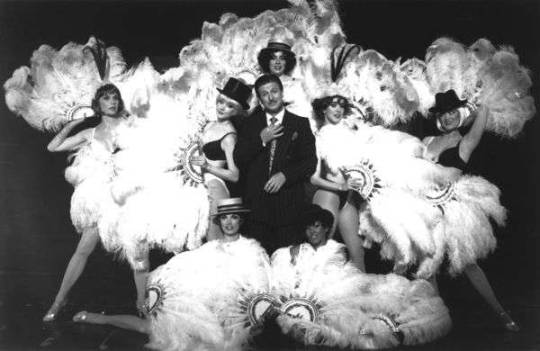
“Bob Fosse would love [this production],” it was commended at the time, “Especially the song-and-dance performance of Bebe Neuwirth who knocks everyone’s socks off.” High praise.
Bebe was also singled out for her “unending energy”, but Juliet too received praise in being “sultry and funny”. Together, the pair were called “separate but equal knockouts” and an “excellent combination”.
Juliet was 56 at the time, and sadly died just four years later. Just one year after the production though, Juliet was recorded as saying, “In fact, we’re thinking of doing it next year and taking it out on the road.”
Evidently that plan never materialised. But it is interesting to note the varied and many comments that were made as to the possibility of the show having a further life.
Bebe at the time had no recollection that the show might be taken further, saying “I didn’t know anything about that.” Ann Reinking years later would remark “no one seemed to think that the time was necessarily ripe for a full-blown Broadway revival.” While the aforementioned LA Times review stated in 1992 there were “unfortunately, no current plans” for movement, it also expressed desire and a call to action for such an event. “Someone out there with taste, money and shrewdness should grab it.”
The expression that a show SHOULD move to Broadway is by no means an indication that a show WILL move. But this review clearly was of enough significance for it to be remembered and referenced by name by someone who was there when it came out at the time, Caitlin Carter, nearly 30 years later. Caitlin was one of the six Merry Murderesses, principally playing Mona (or Lipschitz), at each of this run, Encores!, and on Broadway. She recalled, “Within two days, we got this rave review from the LA Times, saying ‘You need to take the show to Broadway now!’” The press and surrounding discussions clearly created an environment in which “there was a lot of good buzz”, enough for her to reason, “I feel like it planted seeds… People started to think ‘Oh we need to revive this show!’”
The seeds might have taken a few years to germinate, but they did indeed produce some very successful and beautiful flowers when they ultimately did.
In contrast with one of the main talking points of the ‘new Chicago’ being its long performance span, one of the first things I mentioned about this 1992 iteration was the rather short length of its run. It is stated that previews started on April 30th, for an opening on May 2nd, with the show disappearing in its final performance on May 17th. Less than a fleeting 3 weeks in total.
Caitlin Carter discussed the 1992 opening on Stars in the House recently. It’s a topic of note given that their opening night was pushed back from the intended date by two days, meaning Ann Reinking and Rob Marshall had already left and never even saw the production. “The night we were supposed to open in Long Beach was the Rodney King riots.”
Local newspapers at the time when covering the show referenced this large and significant event, by noting the additional two performances added in compensation “because of recent interruptions in area social life.”
It sounds rather quaint put like that. In comparison, the horror and violence of what was actually going on can be statistically summated as ultimately leaving 63 people dead, over 2300 injured, and more than 12,000 having been arrested, in light of the aftermath of the treatment faced by Rodney King. Or more explicitly, the use of excessive violence against a black man at police hands with videotaped footage.
A slightly later published review wrote of how this staging was thus “timely” – in reference to an observed state of “the nation’s moral collapse”.
‘Timeliness’ is a matter often referenced when discussing why the 1996 revival too was of such success. The connection is frequently made as to how this time, the revival resonated with public sentiment so strongly – far more than in 1975 when the original appeared – in part because of the “exploding headlines surrounding the OJ Simpson murder case”. The resulting legal and public furore around this trial directly correlates with the backbone and heart of the musical itself.
I'm writing this piece now at the time of the ongoing trial to determine the verdict of George Floyd’s murder, another black man suffering excessive and ultimately fatal violence at police hands with videotaped footage.
I think the point is that this is never untimely. And that the nation is seldom not in some form of ‘moral collapse’, or facing events that have ramifications to do with the legal system and are emotionally incendiary on a highly public level.
Which perhaps is why Chicago worked so well not just in 1996, but also right up to the present day.
Undoubtedly, we live in a climate where the impact of events is determined not just by the events themselves, but also the manner in which they are reported in the media. Events involving some turmoil and public outrage at the state and outcome of the legal system are not getting any fewer or further between. But the emphasis on the media in an increasingly and unceasingly digital age is certainty only growing.
#chicago#chicago the musical#chicago musical#bebe neuwirth#juliet prowse#ann reinking#bob fosse#fosse#dance#broadway#musicals#theatre#theatre history#choreography#gwen verdon#chita rivera#long reads#writing#george floyd#rodney king#oj simpson#dancing#dancer#andrew lloyd webber#cats the musical#musical theatre
80 notes
·
View notes
Text
GUIDE : CANON DIVERGENCE, POST S5A AFTER CONQUERING KATTEGAT to clarify how the journey of my portrayal for Ivar deviates from the interpretation of the show - trigger warning for child death and a warning for heavy s5 spoilers !
I am mostly concerned about the second half of season 5 which, in my opinion, has taken an abrupt and rather unreasonable turn on Ivar. Too much, too quickly, especially upon considering a few key moments from the first half of season 5. I have no intention to erase everything from the original show content because I can partially understand where the show did foreshadow some of his actions, but I want to approach most events from a different point of view as well as establishing a different motivation which is not based on a simplified explanation such as a character who develops a god complex. Long story short, my portrayal for Ivar is primarily based on his character development & character growth which happened throughout the first half of season 5 and I consider him highly canon divergent.
I am not saying I’m writing a “better” version of Ivar. I’m only saying I’m writing a different and more personal ( for me as a writer ) version of him.
“ WHAT IS IT ABOUT THE WORD KING THAT MAKES EVEN REASONABLE PEOPLE BEHAVE LIKE IDIOTS ? ”
He can not, nor want to, empathize why most men consider becoming king as the highest achievement one could reach. It’s beyond him how far men will go just to burden themselves with the responsibility over an entire community. He does not want to become king, & by extent, I am also inclined not to support the idea that he wants to be a god. The only reason why he cares about becoming the ruler of Kattegat is to overthrow Lagertha’s rule and to take her place in stead, to mock her as much as he’s able to for as long as she’s on the run. However, in the long term he has no interest to claim a throne which won’t deliver the glory & recognition he seeks. He suspects that, upon keeping the throne & keeping a tight control on everything that’s happening within Kattegat, he will irritate Lagertha enough to have her engage an attempt to re — conquer Kattegat.
Let me clarify: HE IS NOT A GOOD KING OR WHATSOEVER, and he’s aware that it’s not peasants, villagers & slaves who will respect him, but Vikings fighting & winning battles with and for him. For one, because the residents of Kattegat still love their former queen Lagertha, but also because Ivar’s true strength belongs on the battlefield considering he’s a tactical genius with a keen mind. He’s a conqueror & a defender, not a ruler.
IVAR THE GOD !?
The ceremony, to celebrate Ivar the god, is also something which I will consider with a different motivation. It’s not Ivar’s intention to celebrate himself as a god nor to lie about the woman’s identity they are about to sacrifice. He does not claim they have caught Lagertha and will burn her to revenge the death of his own mother. Instead he spins a narrative in which he promises Kattegat that this woman symbolizes Lagertha & the deep pain as well as hatred & wrath she brought upon him. He tells Kattegat that sacrificing this woman shall be enough to the gods to consider the promise Ivar made ( to revenge his mother’s death, ) as fulfilled. However, it does not change how the majority of Kattegat feels about Ivar on the throne. Following scenes which concern his god complex are— not accepted into my portrayal. Does he make his own brother as well as the majority of his subjects feel worthless under his reign ? Yes. They still have their reasons to betray him & to want him overthrown, but he is not a ruthless ruler who executes countless of his own people just because of some vandalism.
Note however, that Ivar IS commonly considered and believed to be a descendant from Odin. It’s always been delivered by all of Norway that Ragnar, Ivar’s father, is descendant of Odin. Which is something Ragnar himself claimed, too.
“ IF SHE WAS A VIRGIN, HOW COULD SHE BE A MOTHER ? ”
When Freydis tells him that she’s expecting a child, Ivar knows he can not be the legitimate father & that she is lying to him about his fatherhood. To me it makes little sense that someone as smart as Ivar, someone who scoffs at Christians who believe that Virgin Mary gives birth to their prophet despite being a virgin, readily accepts Freydis’ lie that he’s the father of her child despite his impotence. I also do not see any romantic feelings involved on Ivar’s part, for he knows that Freydis is using him as much as he is using her. However, I am inclined to consider it reasonable that a character who’s been exposed to many betrayals and who has always been underestimated before, that he decides not to question her & even uses her pregnancy for his own advantage. I consider their relationship rather toxic - on both sides - because neither of them is innocent - which is exactly why I consider their bond a result out of convenience but not necessarily, genuinely, based on love. In the end Ivar even tells her that he did not really love her, or doesn’t think he did.
Upon the birth of Baldur, a baby with severe dysmorphic features, so much it will not be able to drink from its mother’s breast, Ivar did decide to release Baldur from a life full of pain. Ivar could never quite forgive nor forget that he’s been forced to live a life in which he’s almost always in some kind of pain, to grow up angry because he is either exposed to pity or mockery, and to be underestimated no matter his achievements. Unlike how it happens on the show, Ivar killed Baldur himself to make sure he won’t suffer dying, at least.
IVAR AND THE SEER.
Ivar killing the seer out of sheer spite and in a moment of anger ? During a scene in which it seems very likely that the seer is about to die anyway ? We are going to approach this just a little bit differently as well. Ivar is many things, ruthless and impulsive among them, but if we consider how much he regrets accidentally killing Sigurd just because he antagonized him, I am not inclined to believe he didn’t learn anything from his mistake then. In his bitterness towards the seer it’s also not quite unreasonable to imagine he just watches him die and suffer naturally. However, upon knowing how little his subjects trust him already, he still decided to bury & burn the body.
#—— III. HEADCANON : WE / CEASELESSLY MUSING AND SEEKING THE SPHERES / FOR SOUL AND BODY HAVE NO BOUNDS#this is actually three years old#i have adjusted the wording a little but surprisingly i still agree with my past self#in which season 5b is and always will be a mess if you are asking me#i do not particularly like to erase canon events entirely so... i am simply approaching them differently#i probably forgot about quite a few things concerning 5b#that's because i am refusing to rewatch season 5b#asdfgghjkl
8 notes
·
View notes
Text
VK Character Analysis: Rido Kuran
Rido is a complete, messed up, SOB, but I still like him as a character because he is simply such a fun villain. If I were to place him in that alignment chart thing, he would be “chaotic evil” without a doubt.
While he is generally seen as a creepy, sister-obsessed, maniac, I really believe he was different earlier in his life.
This analysis is based off the Rido we see in the manga and the light novel, NOT the Rido in the anime, since the anime was trash and deviated from the manga when it came to his arc. Anyway, at the start of the post, I will go over the info from the light novel and manga, next will be my headcanons of him as a young man and at the end is my interpretation of him when he was crazy, as we see him in the original series.
XXX
The Deranged Love story in the Fleeting Dreams light novel talks about Rido’s obsession with Juri and gives some info on their past. However, when compared to the original VK series there are several points that don’t add up, and some parts of the light novel simply make no sense.
First, Both VKM and the light novel mention that Rido killed his parents and presumably devoured them to take their powers. That makes sense, it seems like something he would do. What doesn’t make sense to me is the timeline. When exactly did he kill his parents?
All the light novel tells us is that he killed them immediately after they engaged him to Shizuka. Is this around the time Haruka and Juri got married? I always assumed Haruka and Juri have been married for a while, like at least 1000 years. If this is the case, within that time period, how can they not notice that their parents are dead and that their brother killed them?
Or does their murder occur closer to the time Juri got pregnant? But this doesn’t make sense either because Rido referred to Shizuka as a “small child” when he killed his parents, and by the time Juri was pregnant with Yuki’s real brother, Shizuka was probably already at least one or two thousand years old. Unless Shizuka is much younger than we thought? So when exactly Rido kills his parents is quite the mystery.
Secondly, How did he kill his parents?
I assume the older a pureblood, the more powerful they are. So how can he, by himself, kill his parents, both of whom are older and more powerful than him? I doubt his dad was a weakling because as former king of vampires, he should be quite powerful. In the light novel, it seems his parents were already wary of him and wanted to keep him away from Juri. Thus they wouldn’t completely let their guard down around him. And its not like Rido could carry around a hunter sword with him without it being noticed. Even if he was carrying something small like a dagger, his parents should have been able to overwhelm him in a fight since its 2 vs 1.
Kaname has commented that “purebloods have equal powers, so they would only exhaust each other in battle”; basically it is hard to kill another pureblood unless you have some advantage (e.g. Shizuka being already wounded by Zero’s hunter gun). So the only logical way Rido can kill his parents is if he catches them off guard, such as when they are taking a centuries long slumber in the family mausoleum, basically doing what Sara did to Hanadagi.
Thirdly, another point that makes no sense is that Rido in the light novel says:
“My parents had taken my precious Juri far away from me and made it so that we could never meet.”
How exactly did his parents take Juri away and stop them from ever meeting again? Send her abroad with no intention of ever letting her return? And yet the manga clearly contradicts that, because Rido is still in contact with Haruka and Juri, he was there to see their firstborn baby!
Fourthly, this is a small detail that has always irked me: In the manga, when Yuki’s brother peed on him, Rido mentions that he used to change his siblings’ diapers when they were babies.
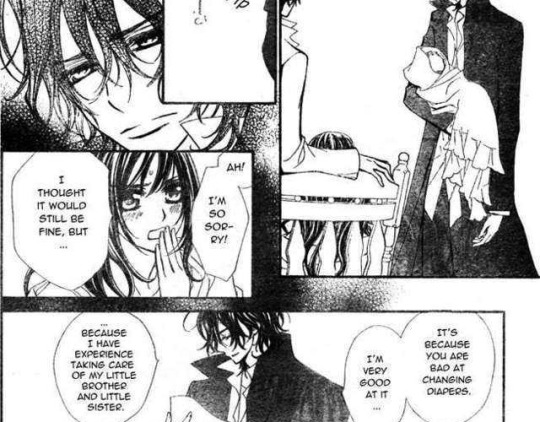
However the light novel kind of contradicts that, because young Rido upon being called in to meet his baby sister says: “I will confess that newborns seemed very uninteresting to me at that time”; does this sound like an older brother that would change his younger siblings’ diapers? It sounds like a guy who would leave baby care to the nannies and stay far away from soiled diapers.
Finally, we get to the biggest illogical point in the light novel: Rido was a psychopath that just randomly developed an obsession upon seeing the newborn Juri.
“ It was in that moment – somewhere in the depths of my being – something abruptly flared to life. […] I was overwhelmed by the urge to devour her.”
No normal person just out of the blue feels the urge to consume a baby, only crazy people do. The rest of the light novel story continues depicting Rido as a psychopath. Their parents notice there is something wrong with their son because the mom slaps Rido and starts to keep him away from Juri. Adding on to this portrayal of him as batshit crazy, after he (somehow) kills his parents, he says the following:
“That’s what you get for getting in my way, you naughty things…”
LOL, who in their right mind would call their parents “naughty things”?
My issue is this: I highly doubt Rido was crazy from the start, because it would make no sense. If Rido was crazy, how the hell could Juri and Haruka not have noticed for over 3000 years?! Even the dumbest person would get a clue that their brother was crazy after just 30 years, much less 3000 years. They trusted him enough to let him hold their baby, so they clearly believed Rido was not crazy. There is no way that Juri and Haruka were that stupid and blind. Thus, I doubt that Rido was crazy at the start of his life. So, this aspect of the light novel is just total BS to me.
IF Rido really was crazy from the start, then his mom and dad were bad parents. Yes, it makes sense to keep Juri away from Rido if he really were a psychopath, but their other actions were just extremely irresponsible and selfish. If you know your son is dangerous, maybe you should address this issue properly. After all, he is a pureblood and if you don’t deal with the problem, there will be huge repercussions for everyone given the destructive powers of purebloods.
But instead of taking their son to see a mental health professional like any decent parent would do, Papa and Mama Kuran decided to solve the problem by engaging him off to a “tiny child”. I’m no parenting expert, but I’m sure if your son has mental issues, you definitely should NOT marry him off to any girl. Even if they didn’t get him some help, they should have at least locked him up like Shizuka to ensure he didn’t harm anyone... but they just let him roam free.
If this is the extent of their problem-solving ability, then it’s for the best that they ended the monarchy because they must have been cruddy rulers. But who knows, I’ll give them the benefit of the doubt, maybe they believed the “tiny child” they chose for him has a PhD in psychology and can provide their son with the help he clearly needs. ¯\_(ツ)_/¯
Anyway, I consider the light novel to be only pseudo-canon since it was inspired by Hino but written by someone else (Ayuna Fujisaka), so I will just ignore the parts that don’t make sense and keep the parts that do.
XXX
This following section is what I believe Rido to have been like when he was a (sane) young man, based on the info in the manga and the few bits that do make sense in the light novel.
Since Rido was the oldest son and born in a time when the Kurans were still the ruling family, he probably grew up with a lot of pressure and expectations as he was the crown prince. Given these conditions, he was most likely serious and hardworking, doing his best to live up to those expectations and preparing to be the next king (kinda like Eins in The Royal Tutor LOL).
He was also probably a bit older than Haruka and Juri (because according to the manga he has experience changing their diapers and taking care of them). And since he was probably busy with his princely duties, he did not spend a bunch of time with his siblings and thus Haruka and Juri were naturally closer to one another than Juri was to him. She probably saw him a respected older brother but not as reachable and easy to connect to as Haruka.
Rido was probably arrogant, possessive, and entitled even at the start (though at much milder levels than towards the end), which makes sense given his background. Not only was he a pureblood, but the crown prince too. And since he was prince, he probably had to deal with the dog-eat-dog world of politics from a young age, so that probably made him more cynical and darker than his siblings who had much less pressure and responsibility. It would almost be shocking if he was a humble and kind person instead.
Anyway, according to the custom of primogeniture, both the throne and Juri should have been his. Since it was tradition of the Kurans to marry their siblings, it only makes sense that as the oldest son and legitimate heir, he was the one that Juri should have married. Yet for whatever reason, their dad decided to end the monarchy, which must have been a huge blow to Rido who spent his whole life preparing to be the next king. He probably drove himself to despair questioning why and if there was something wrong with him that his father would pull such a move.
Then Rido probably got another big slap to the face: Juri choosing to marry Haruka instead of him, with his parents probably giving them their blessings. So not only has he lost the throne, he also lost the fiancée that should have been his according to precedent. And Juri choosing Haruka probably made Rido lose face among their society, since people would naturally wonder why Juri spurned tradition and married the second son instead.
(Actually, it wouldn’t matter if the monarchy getting dissolved took place first or if Juri choosing Haruka took place first, the point is both happened and it screwed him up.)
Rido most likely didn’t love Juri, but simply believed he did. He probably conflated Juri with what he lost/ what should have been his by birthright and became unhealthily obsessed with the idea of her. It didn’t help that the one Juri chose was Haruka, who we know has a mild and kind personality. To someone like Rido, those are traits probably considered “weak”, and thus he probably never thought of Haruka as his rival. Therefore, the fact that he lost to Haruka of all people shocked him, and there might have been some anger and sorrow at being betrayed by a sibling. So anyway, Rido’s emotions as well as his ego got clobbered.
But fate is not done with him yet! His parents most likely decided to engage him to Shizuka “without his consent” around the time that Haruka and Juri got engaged/married. They might have rushed to engage him off to whoever was available at that time (unluckily for Shizuka it happened to be her), hoping to get him out of the way of his siblings’ happiness. Rido probably was pissed, since not only does he not get to choose his new fiancée, the one chosen for him hails from a clan with a history of supposedly going insane, instead of someone with a less problematic pedigree. His parents really doing him dirty lol.
I think he really had some deep-rooted problems with his parents. Sometimes parents just don’t like their child, because of personality and ideological differences…Anyway, they were definitely in a strained relationship which would explain why Rido could go so far to kill his own parents and feel no guilt over it.
XXX
Finally, towards the end of his life he really just lost it.
Rido probably tried to keep up appearances and act like everything is okay and that his world is not falling apart, thus allowing Juri and Haruka to still trust him. But over the years he just stewed in his anger against his parents, his siblings and the world in general and turned into a very bitter and hateful person on the inside. And although he probably tried to suppress his growing darkness, his bad traits got amped up while his better traits died. It was probably extremely infuriating for him to see his siblings so happy in their pink glittery world while he himself was drowning in darkness.
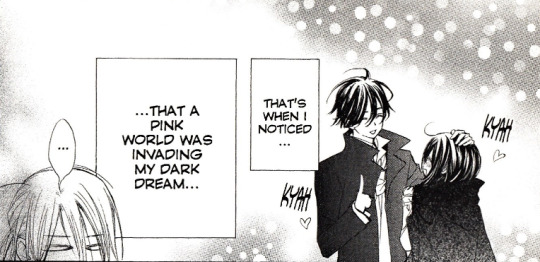
(Even Kaien was annoyed by Haruka and Juri’s “pink world”, imagine an already salty and bitter Rido seeing this type of scene for centuries and just frothing with rage on the inside LOL)
So Rido became a sadistic ass towards the end, taking his anger out on people that have nothing to do with it. He tried to make Shizuka miserable and force her to be docile and had no luck with that but succeeded in breaking Senri’s mom and driving the poor woman crazy. Though if you think about it, in a way he did succeed in breaking Shizuka too… he caused her lover’s death and when she lost her lover, she basically lost her will to live.
Hino showed how talented Rido is at antagonizing others. While he possessed Senri, he intentionally hurt Senri’s body to toy with Takuma.
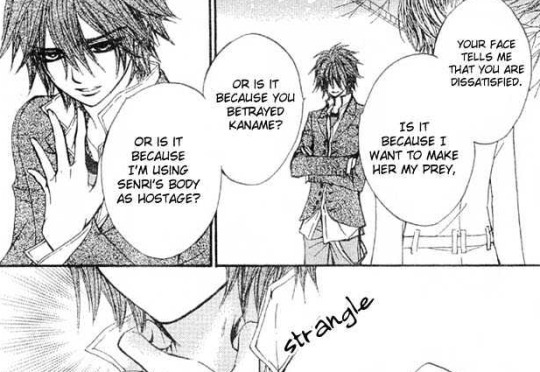
Even after his death, his dregs were tormenting Kaname by pointing out all his inner concerns, taunting Kaname about how he has no hope left.
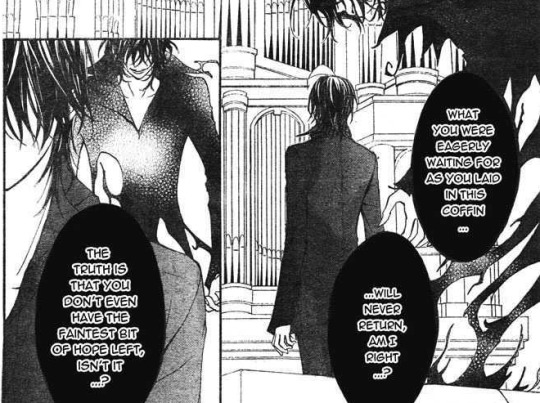
In VKM, Yuki mentions Rido as someone “with overwhelming desires that only plunge the world around [him] into misery.” Overall, Rido probably got his giggles by making others miserable.
Besides getting high off ruining the lives of other people, he was just a bastard in general. He used everyone around him as tools, even his own sons. Unlike Shizuka or Kaname, he did not care about his subordinates at all, to him they were just “appetizers” and expendables. He also had zero reservations about forcing lower vampires to submit to his will.
Anyway, Rido probably was already a bitter jackass but he really snapped when he found out Juri was pregnant and would start a happy little family with Haruka. Maybe he was idiotically holding onto hope that as long as Juri didn’t have a kid, he still had a chance? Regardless, it was at that point that he gave up any vestiges of humanity he had left and decided to just pursue power instead.
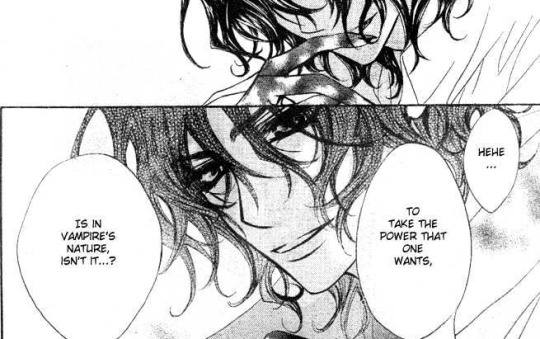
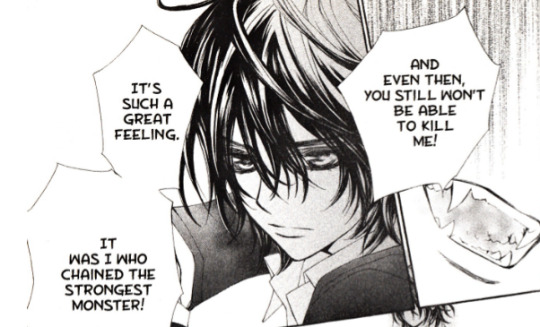
With no hope left he just decided to give in to his primitive instincts and lust after power, at the expense of family ties. In a way, he might have felt betrayed by his family, and reasoned with himself that unlike the throne and Juri, at least power won’t be stolen away.
BTW, I think his decision to sacrifice Yuki’s real brother to ancestor Kaname was spontaneous and not premeditated. After all, crazy people are unlikely to plan things in advance and just do as their whims dictate...
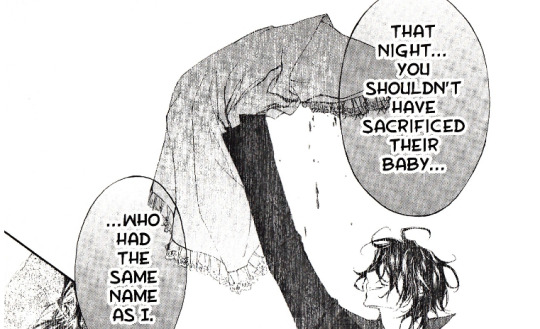
Maybe it came to him right when he stared at Juri holding her newborn.
“It’s such irony that this baby was named ‘Kaname’ like you. That’s what got me started thinking of this.”
Because his plan (if he had one) sucked. He should have known that the famished, revived ancestor would attack him, since the blood of a tiny baby was clearly not enough. And yet he made no preparations to fend off such an attack and ended up getting drained by Kaname.
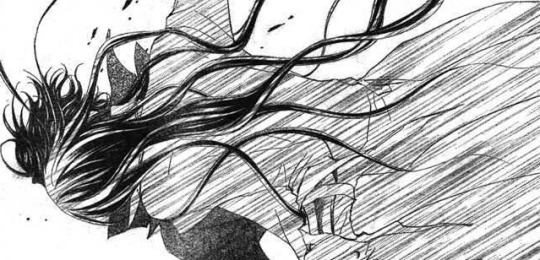
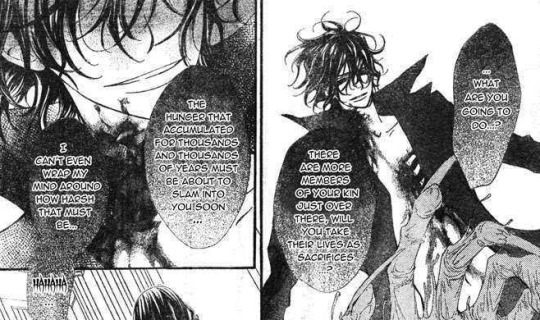
As a side note, Haruka could have killed Rido right then, when Rido was badly wounded by ancestor Kaname.
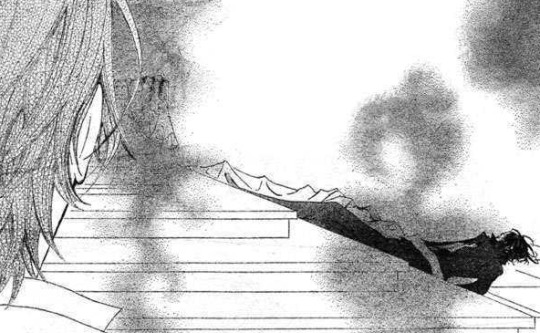
But he didn’t, and chose to have Rido imprisoned by the Senate instead. Haruka should have known that Rido would never give up on destroying his family as long as he lived, so the logical thing would have been to kill him. Even Rido mentions this later when he returned for Yuki.
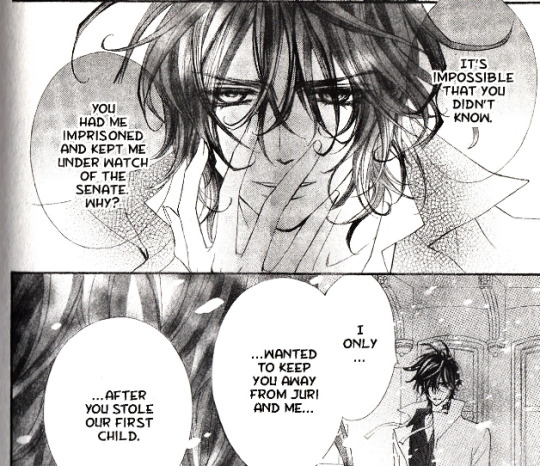
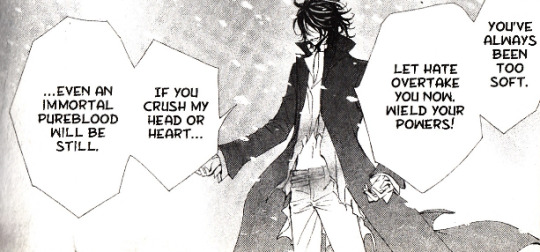
While Haruka’s pacifist nature played a part in this, I think he also restrained himself from giving in to vengeful rage partly out of the fact that they are family, and more likely out of guilt. Perhaps Haruka had always felt guilty for marrying Juri and realized that he was partly responsible for driving Rido insane.
Anyway, Rido crossed the line by killing a helpless baby and basically burned all his bridges. At this point he didn’t really give any fucks anymore.
Asato mentions how Rido was like a child, even though he has lived so long. I think the analogy fits, because Rido acted like a child throwing a tantrum, trying to destroy everything and doing whatever he pleased with no regard for consequences or others.
In a sense, like Shizuka, Rido had already lost his will to go on living. The only thing keeping him hanging on was the need to lash out. Even though he acted like he was pursuing greater power, aiming to consume Kaname and Yuki to become more powerful, he wasn’t actually trying.
If he was serious, he would not have gotten easily distracted, suddenly deciding to have Yuki replace Juri instead of continuing with the plan to devour her. Rido also didn’t bother trying to fight seriously at the end and Zero comments on this.
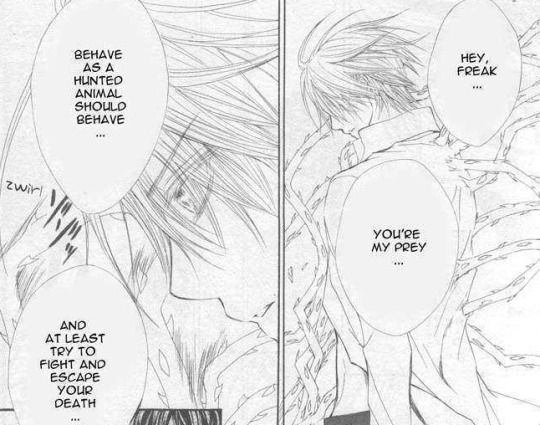
Otherwise Zero and Yuki together could not have beaten him, given how Rido is much older/powerful and consumed at least 2 other purebloods. Even Sara said that Rido was acting foolishly reckless, saying he was just having fun.
XXX
Overall, given this interpretation of Rido, I actually feel bad for him. I believe that he drove himself crazy wondering why his parents ended the monarchy instead of letting him be the next king, and wondering why Juri chose Haruka over him. Those questions probably haunted him for centuries.

That feeling that you tried your best, did everything you were supposed to, but still ended up with nothing is something I can relate to. Sometimes one just wants to watch the world burn given how unjust life usually is (even though logically we know it is wrong to feel this way). So yeah, these are my headcanons and analysis of Rido, who I prefer to see as a deeper/more interesting character than just a sis-con psychopath LOL.
173 notes
·
View notes
Text
On Heteronormativity and the JK 2019 Rumors
I finally found the source of some of the nervousness/anxiety I’ve been seeing in asks lately about JK and the tattooist, and I have some thoughts.
First: I don’t want to actually talk about that rumor. It’s just rehashing old ground, and I don’t think there’s any new insight to gain. No matter what happened, we know it significantly impacted JK in a negative way, and it’s best left to the past.
Second: This isn’t a response to a specific blogger. I read the original post and didn’t have an issue with it. Instead I’m just taking an opportunity to use this topic as a way to talk about something that comes up a lot: heteronormativity.
The general opinion circling is that many people in SK and a few other countries in East Asia assume that JK must have been dating the tattooist with whom he was photographed.
Why? Because of the physical affection he showed her.
Note that I have no way to prove this is true; I wouldn’t know where to look to get a temperature on what K-ARMY thinks. But we do know that the photos caused a huge stir when they came out, and many people speculated that JK was romantically linked with this person.
I think this emphasizes something that I’ve also seen reflected in kdramas and other media: that physical affection between men and women is considered significant and highly meaningful when it happens.
This is obviously not specific to South Korea – touch is considered a major part of romantic relationships just about everywhere. But considering the location and nationality of BTS, how it’s viewed in SK is particularly relevant.
It doesn’t surprise me, then, that such behavior would be viewed as suspicious. That’s unfair in itself – men and women can be friends, and be physically affectionate, and have it not mean anything more than that. It’s an imposed societal perception, and those are often inaccurate and constricting.
But here’s the interesting thing: we know JM and JK (and all the members of BTS) have shown a good deal more physical affection than the little we saw in those photos. We know skinship and closeness are a part of their bond. We have also seen KM test the bounds of physical affection in friendship, many times. But for some reason, that’s never really considered suspicious (except for a subset of the fandom, and we’re often called delulu for thinking such things).
The assumption that this behavior means nothing between two men but is clear evidence of a relationship between a man and a woman is heteronormativity.
To be clear, heteronormativity isn’t just a problem in any one place. For example, American entertainer JoJo Siwa recently posted a video of herself lip-syncing to a specific line in Lady Gaga’s song Born This Way (“No matter gay, straight or bi, lesbian, transgender life…”) while wearing rainbows. Many people took it as a signal that she was LGBTQ, but there was pushback against speculating about her LGBTQ status – even though speculation was driven by a seemingly intentional statement.
There were efforts to minimize the message that she sent (“What if she was just singing along? What if the lyrics were a coincidence?” Sound familiar?). She cleared all the ruckus up pretty quickly by posting a photo of herself wearing a “Best Gay Cousin Ever” t-shirt a day or two later. LOL. Way to go, JoJo. And welcome!
Why do I bring this up? Because this was also a case of heteronormativity. It’s very likely that, prior to her coming out, many people assumed JoJo Siwa was straight – including the parents of her followers. Speculating about her sexuality in that case wouldn’t be viewed as negative, because straight is considered the norm. But suddenly, when she gives a clear indication that she is a part of the LGBTQ community, it’s wrong to think that she meant what she meant. Because straight is the default, and queer is the deviation.
South Korea is more conservative and hasn’t made as many advances in LGBTQ rights. As such, they tend to have closer and more physically affectionate friendships with people of the same sex – because queerness isn’t assumed in the same way it is in Westernized societies.
Even so, kmedia makes it clear that certain things – hand-holding, hugs, prolonged contact – can be considered significant and romantic depending on the context. It’s not as if those gestures never hold any romantic weight – they do. The assumption that JK must be dating someone he hugged demonstrates that.
So, if someone is queer in South Korea, in stands to reason that those things would still be meaningful and significant in a romantic way. It’s just not as visible, because queer relationships aren’t considered possible or acceptable.
Not everything should be explained away as skinship – that would be erasure. For that matter, not every touch or glance between a man and woman should spark dating rumors, either. That response comes from the societal expectation of how these couples should behave – not the inherent value or meaning of the action itself.
It’s always been interesting to me that two opposite sex idols can have very minimal interaction and be assumed to be dating – while idols of the same sex can be basically all over each other with no second thoughts.
At the end of the day, that just comes down to heteronormativity.
28 notes
·
View notes
Note
Hi, please don't be hurt by this comment, but in the future, please be mindful of illustrating white features on your fan art of people of color. There are so few characters that we (POC) can call our own, so it kinda stabs when we see fan creators whitewash our representation. Thank you for reading.
Yeah. Let me have this conversation, because the literal post I made after that portrait of Asami that most likely prompted this comment was a tags-only frustration post about how I actually tried to back that way off and really failed at it. There’s a strong Megan Fox vibe there that just stubbornly refused to go away, and as much as I really don’t think Asami Sato would look like Megan Fox in real life, I also didn’t completely hate the final product.
I apologize if that failure hurt you personally, anon. That was not my intention with it.
There’s a practice element to that kind of work that I just don’t have under my belt for a lot of ethnicities. Part of it is familiarity (I live with a south Asian, and her features are very different from my target here, and though I’ve got my own mixed heritage my family is pretty disgustingly white). Part of it is past interests. My past portrait subjects have been pretty monochromatic in that regard, and honestly not that complicated. There’s no room for interpretation for how much deviation from a base is enough when the character you’re trying to draw is physically portrayed by someone. That’s easy. Conjuring features, either from a series of models or from some base face and then making subtle and increasing alterations for ethnicity? Hard. At least, for me, a hobbyist artist with limited time and divided attentions.
I’m not going to pretend that starting at “classic Hollywood,” having read that line in the season 1 art book comments, and moving from there wasn’t a mistake, but I did. I went looking for Asami’s nose and lips in a finite catalog of potential starlets because I knew that WAS a starting point for her character, and made that my base. That was my first mistake, and one I immediately acknowledged. But torn between actually liking the product and realizing I didn’t do enough to it (and constrained in this program on this device/program to a finite number of layers, which drives me nuts in portrait work as it turns out), I called the experiment complete, and posted it.
It’s an attempt, and part of the struggle I’m going to continue with is that an animated character’s features are fairly simple compared to that of an actual human being, and one of the reasons I want to keep trying is there’s not a lot of portrait work out there that I see and think, “oh, that’s Asami.” (I definitely get Korra more in what I’ve seen, but even with her there’s one feature I’ll debate you over because it’s so important to recognition and that’s very likely the least Asian feature on Asami’s face, as well). What I’ve seen is highly interpretive by virtue of the source material being iffy, probably (and definitely more skillfully) representative of at least one of the cultures Asami or Korra’s heritages are based on, but often not terribly reminiscent of the original concept, to me. That’s fine. Fanart is interpretive, evolutionary, and personal, and these are the kinds of representation most often (and rightfully) criticized in LoK. That art needs to be made.
Some of us are just not very good at bridging that gap at this particular point in our art careers. I’m aware, and I’m trying. There will hopefully be better attempts to come. I like to think of my work as something that evolves.
But I’m four years out of practice with portraits. That’s the first thing I’ve started AND finished since 2016, and I’m proud of that accomplishment. I’m not going to hide my art away because it’s not perfect, and I’d be horrified if anyone thought that was necessary because their first or second or fifteenth or two hundredth attempt wasn’t perfectly representative of the character they’re trying to portray. I understand the concern that drove you to this comment, and encourage you to very gently nudge artists toward accepting the criticisms as a point of necessary improvement. I also ask that you have some degree of patience with people. Improving one’s art is a matter of practice, and muses are fickle creatures. I’m old enough and mature enough to understand that, and take criticism. Just be gentle with others who might not be.
#anonymous#now...if tou’re actually talking about korra’s skin tone then come back for another conversation#but honestly I expected something like this ehen I posted it so don’t apologize for anyhting here#just try to be patient. i’ve got a meager pinterest board of better references and a supportive spouse helping me scout#it’ll get better#about art#asks
2 notes
·
View notes
Text
A little bit of the history of U.S imperialism after the fall of the U.S.S.R via /r/communism
A little bit of the history of U.S imperialism after the fall of the U.S.S.R
The post seeks to explain the postmodern developments of American imperialism. It was originally made in Portuguese, transcribed to English quickly with Google Translate and I tried to fix all grammatical errors I could find. Many people come to this subreddit asking about Russia, Syria, Yemen and other specific countries. As such, I believe this post to be useful.
The major contradiction that surrounds the globe is that of American imperialism and the most diverse manifestations of anti-imperialism and counter-imperialism. The death of the USSR over a convulsion of multinational neoliberalism created the conditions for US neoliberal momentum and the submission of the globe to its will.
In Yugoslavia, the last bastion of European socialism (Portugal's '' socialists '' make us laugh at their austerity) was consumed by German-funded nationalist barbarism (with an interest in Croatia, Slovenia and its possibilities for projection into Eastern Europe) and American. The IMF's loans to Yugoslavia, as always, demanded neoliberal reforms which, to the dissatisfaction of such organizations, Tito and Milosevic only submitted to. A false image of the Serbs as mass rapists is created, sparing Croatian crimes; of Bosnia and Kosovars of media attention. Eventually, Yugoslavia is dismantled in a sinister threat to Russia. A puppet state for American interests is created in Kosovo, the extraction of mineral resources included on that program. Montenegro and Serbia gradually leave Russia's orbit (the former more than the latter) creating a tense geopolitical scenario.
The oil crisis in the 20th century proved to be the Bush administration's biggest concern, it planning invasions against Saddam Hussein and the Taliban even before 9/11. Saudi Arabia had become too big, too ambitious to be controlled by the United States. It financed Islamist terrorism and Wahhabi institutions around the world in a rejection of Westernist principles. The importance of Saudi Arabia for the free movement of oil, as well as its collaboration on many issues of international politics and the purchase of American weapons, prevented any possibility of extensive publication of these findings, even when the financing of Al Qaeda by the Al-Saud and assistance with its state intelligence culminated in 9/11. However, the ignorance of the American public could be exploited from the trauma of Al-Qaeda to "" fight terrorism and the nations that shelter it "" in a relatively disconnected way with 9/11.
In Iraq, Dick Cheney and other neocons were exhausted from Saddam Hussein's use of oil as a bargaining chip. By turning on and off the taps of black gold to erratically, crude oil prices threatened to rise, against the interests of refineries across the globe and possibly creating a global energy crisis (Iraq's oil importance cannot be underestimated, it is considered by some analysts greater than Saudi Arabia). The invasion of Iraq was not exactly aimed at the extraction of these oil resources by the imperial powers, although this was an important bonus that motivated the participation of the United Kingdom, but simply to put that oil in motion. China and Russia would soon take some of the pie with their state-owned companies, something not ideal but acceptable in the context of American interests.
In Afghanistan, a progressive socialist revolution with feminist characteristics was stifled in the Cold War with a blackest reaction supported by the USA. It did not interest the pastoralists and the old elites in Afghanistan the programs of the Sardur revolution and the United States gave moral support; financial and military support to their counter-revolution efforts. Afghanistan was not a Soviet republic, but it was part of its sphere of influence, hence the importance of fighting Afghanistan together with the vassals of Pakistan and Saudi Arabia, interested in Sunni uprisings. China has also financed opposition groups in its sad but understandable policy to combat Kruschevian revisionism. Eventually, Afghanistan was dominated by the Taliban and their female genital mutilation; destruction of Western icons (including a Greek heritage in Afghanistan until then) and a ban on music. The Taliban was only fought at the moment that it no longer collaborated with the US in the construction by USATCO of an oil pipeline starting in Uzbekistan and passing through Afghanistan, requiring intervention. Officially, the Taliban was hunted for cooperation with al Qaeda, which was real.
In Somalia, a war was declared on one of Somalia's first stable governments in the 21st century: the ICU, for its Islamist features. Thanks to its wealth of resources such as uranium and oil as well as its connection to the Gulf of Aden where much of the world's oil came from, Somalia has always been imperialized by the IMF and NATO. The local fishing industry has been destroyed both by radioactive waste dumped by European companies in the water and by the massive technological scale extraction of fish by foreign companies within Somalia's territorial waters.
Not all war is war properly said. Professor Gene Sharp's manuals created a guide on how to use civilian demonstrations, strikes and boycotts in the service of the CIA. The best example was the US incentive to the Cedar Revolution, a series of protests in Lebanon that put an end to the Syrian occupation, resulting from civil wars between religious and ethnic groups. Both Syria and Iraq were pan-Arabists, that is, they aimed at uniting all Arab nations in a single country, countries cut in half by the state of Israel. Secular and socialist pan-Arabism posed an obvious threat to the strategic interests of the United States and its allies Israel and Saudi Arabia, hence the opposition to Syria that would later become war. Note that there is no proletarian dictatorship in Syria and '' socialism '' means in practice a greater social democracy in intensity than in the West.
The Bush wars have claimed many lives, innocent or 'combatants', destroying the infrastructure of these countries and creating political instability. NATO's imperialist policy not only achieves its strategic objectives, it also destroys recipient countries. This is partly intentional, like negligent homicide. The destruction of Iraq and Afghanistan and, as we shall see, in Libya made possible both an initial expansion of the military-industrial complex that influences policy in the USA and reconstruction contracts that created inflationary cycles (that is, monetary expansion) that were taken advantage of by USA. They destroy and then rebuild, both phases of the capitalist process of avoiding contraction cycles by expanding the outside world.
One of the reasons that American imperialism went into crisis was that it went too far. The destruction of Yugoslavia, the creation of new oil routes in Afghanistan that deviated from Russia (on which the first world countries were highly dependent), oil penetration in Central Asia, the financing of anti-Russian politicians in Georgia and Ukraine...again and again the US has abused the world's second largest military power at its weakest moment. This context explains how Vladimir Putin came to power, a right-wing ultranationalist ready to recover Russia's strength not as a stronghold of socialism but as an imperialist force that falls short of the USA, at the taste of the domestic bourgeoisie. As a message, he invaded Georgia who planned to become a NATO member. Russia's recovery would have great implications for all of Eurasia, as we all know from the screams of the media and the heightening of tensions in Ukraine, always in the same West vs. East paradigm.
Belarus recently entered the Russia-US dispute. With a largely state-owned economy that never underwent neoliberal shock therapies (despite the lack of retirement among other capitalist aspects) and in Russia's sphere of influence, the relationship between the two degenerated by Lukansheko's resistance to Putin's attempts at absorption in a Union State, looking for new energy sources in Norway. This new vulnerability in Belarus was exploited by the imperialists through the traditional method of "promoting democracy" and Russian paramilitaries are known to be watching the situation.
Although the United States is not very directly involved, one cannot speak of Russia's geopolitics without mentioning the war between Armenia and Azerbaijan, which ended today (?) and lasted 45 days. But frankly, this issue is too complex for me. I will leave a link that I found useful: https://geohistory.today/nagorno-karabakh/#:~:text=The%20Republic%20of%20Nagorno%2DKarabakh,Azerbaijan%20that%20lasted%20until%201994.
Another country the United States has abused the patience of is China. The protests in Tiannamen Square were largely promoted by private charities associated with the West, and were harshly repressed by Deng Xiaoping. Thereafter, the terrorist-buying state of Turkey provided support to separatist Islamist terrorists in Xinjiang, a region of traditionally Turkish and Islamic China. The United States had previously provided assistance to the Tibetan insurgency under Mao, and continued to provide moral and religious support through its institutions. The US strategy with China was to dismember its diverse ethnicities into separate and enemy territories so that it will not be able to project itself geographically across Eurasia, unifying Tibetan separatisms; Mongolians; Uighurs and Hong Kong. Most recently, the US is attemping to force a color revolution in Thailand. Admitting this is no defense of the Thai monarchy but an understanding of its commercial relationship with the U.S and how installing a regime favourable to the West would be a strike against China. The U.S has also pitied Vietnam and China against each other whenever possible.
Like Russia, China has not been shaken by these attempts and has extended its economic and military dominance across the globe. The strong Chinese state-owned industry challenged the neoliberal models of growth and, through a policy based on non-interference in domestic affairs that contrasted with US imperialism, China attracted dozens of peripheral countries to its attention. Thus, we must understand the preference for China as a conscious rejection of the USA. The unified front between China and Russia represents the greatest challenge to the USA in modernity.
The endless wars of the USA could not be sustained indefinitely, requiring endless loans from the most diverse countries. Eventually, the irrationalism of bankers typical of neoliberalism created the crisis of 2008, with a deficit that required more loans and, consequently, more debt and more deficit. Income inequality has exploded. It was under these conditions that Barack Obama was elected, promising to resolve the insoluble contradictions of American imperialism on a progressive paradigm.
Obama did not comply with any of these proposals and in fact expanded the scope of the war beyond Bush, killing more people with drones. It is important to note that the war in Afghanistan was not over yet and Osama was not captured. It was in this context that Obama decided to replace soldiers with automatic drones that were supposed to promise fewer civilian deaths, and expanded the war to Pakistan to fight another Taliban front.
But the drones were more useful for saving the lives of American soldiers (which was probably the intention) than for Pakistanis and Afghans. Death from heaven created trauma for the local population, who avoided going to weddings because of the constant errors in recognition of drones. As stated, the US wars may not literally target the killing of civilians, but they are negligent in causing them.
Expanding the war in Afghanistan would not be enough and Obama declared three completely new wars: that of Libya, Yemen and Syria.
Libya had long been a stumbling block in the US. Allied to the USSR while it existed, Colonel Muammar Gaddafi had an anti-imperialist and socialist program of a similar nature to the one I described from Syria, that is, more of an intense social democracy than a dictatorship of the proletariat. Gaddafi also sought to overcome the tribalisms that divided Libya and harmful traditions such as the prohibition of divorce, by greatly expanding women's rights. Gaddafi criticized the democratic models of the West and proposed a controversial new model of direct democracy, Jamarihya. Regardless of the reservations that the reader has with this method, he was certainly more democratic than the Sunni Islamic terrorism that the United States financed in order to destroy this bastion of resistance to the Empire, consuming Libya in a civil war horrible enough for Obama to admit it as '' error '' in an abstract way. As always, European powers emerged from the air to protect oil. Gaddafi went through a phase of surrender and collaboration, dismantling his nuclear program, but he was still killed. This would serve to motivate North Korea not to abandon its nuclear program.
Practically the same thing is happening in Syria, both regarding the United States methods and in the nature of Bashar al Assad. The difference, however, lies in the support of Syria from the unified China-Russia front as well as from the regional power of iran. Only in this way has Bashar managed to stay in power. Iran is a non-secular Shiite nation that was imperialized by the United States under the Shah regime, being overthrown in Ayatollah Komeini's Islamic but anti-imperialist revolution. It is a regional power with large oil reserves and a respectable army, accused of financing the anti-Israeli group Hezbollah.
The situation in Yemen is substantially different. The Zaidi, a very significant Shiite minority in the north of the country who have a history of sovereign states in the region, threatened to expand a Shi'ite revolt over the Gulf states like Bahrain; UAE and Saudi Arabia, all marginalized economically and politically. Saudi Arabia installed a president favorable to its exploration interests, creating a spontaneous zaidi revolt that would be suppressed by the US-Arab junta. To justify the intervention, the US used the decontextualized motto of the zaidi groups of "Death to the USA, death to Israel" as a demonstration of religious extremism. Which is partially understood, but must also be understood as anti-imperialist reaction.
And that's it, folks. Does history end at Yemen? Obviously no. Yet my systematic knowledge ends here.
Submitted November 10, 2020 at 07:55AM by Ckaaiqoos via reddit https://ift.tt/35j2hzo
1 note
·
View note
Text
hlvrai watsonian interpretation concepts
okay buckle in folks because my hyperfixating ass CANNOT let this go and it’s a REAL fuckin long one with a lot of metaphysics nonsense referencing cyberpunk terms, vaguely cthulhu-mythos style reality perception bullshit, and of course a bunch of player-interaction-horseshit thats blatantly the result of undertale and deltarune metaanalysis. Alright, so:
HLVRAI is the result of three different realities on differing ‘Singularity Levels’- points of where an sapient entity reaches a threshold of awareness of levels ‘above’ them that their perception process becomes incomprehensible to their native zones levels- interacting in a domino effect thanks to one certain eldritch entities desire to give his Mixed-Singularity-Level kid a good 37th birthday party at chuck-e-cheese.
These are: Reality 6-3411, Reality P14Y3R, Reality 41VR41, and Proxy-Realities 814354.
Reality 6-3411 is where the entity referred to as Gregory ‘G-Man’ Goodman’s Species resides- a race of enigmatic creatures who regularly interact with lower Singularity Levels in hopes of uplifting them to their level, often incubating their young in those realities in order to better communicate.
G-Man is part of a team charged with interacting with Reality P14Y3R through pre-existing proxy realities, looking for promising candidates- during which he inadvertently began interacting with Reality 41VR41 to a startling degree. Details are fuzzy, but at some point he was graced with a child by a member of that Singularity Level, currently known as Tommy Coolatta.
Tommy, being born into a lower singularity level with no guarantee of reaching one higher, is difficult to care for properly without harm- G-Man made the decision to leave him in an area so he’d be raised by members of that level while G-Man watched from the sidelines for potential Singularity Level Increase- however, time can be hard for ‘higher’- entities to understand, and he didn't realize how long it really had been.
While his employers had a vested interest in Tommy’s case, by the time G-Man is made aware of the circumstances of Tommy’s increasing access to higher-levels of perception of time by his employer’s- beginning with ‘seeing fast’ when drinking soda five years before the Black Mesa Incident and slowly progressing from there- Tommy had been inadvertently trapped in one of those pre-existing Proxy-Realities and could not be extracted without assistance from an entity of Reality P14Y3R interacting with a ‘Player Avatar’ based on Proxy-Realities connected to Reality 41VR41.
Reality P14Y3R is one of many realities that commonly interact with a multitude of naturally-occuring Proxy-Realities, often being interpreted as works of fiction to entities from that said level or being created by those same entities themselves. Entities from this reality are capable of interacting with Proxy-Realities which are naturally occurring buffer-zones that separate this reality to those of it’s ‘fiction’ and vice-versa, making them ideal candidates for Reality 6-3411 to utilize in their machinations- detriments to those ‘Player Avatars’ that happen to be caught in the crossfire from lower Singularity Levels notwithstanding.
In terms familiar to those who played undertale? It’s you!
Proxy-Realities 814354 include a variety of shifting sub-realities, namely taking the form of Half-Life, a science fiction first-person shooter where an entity from Reality P14Y3R takes control of the Player Avatar Gordon Freeman, a scientist working at Black Mesa. Included in this reality are a variety of AI created by entities from Reality P14Y3R, of which a few begin to increase in Singularity Level.
The first to gain proper Singularity is an entity known as Benrey, who proceeds to gain awareness of Reality P14Y3R and subsequently reinterprets their world through that knowledge- they are in a game with a script, a world that is not real, death is meaningless and you will simply heal or respawn in time- the only point is to have fun and make it interesting for the Player.
Benrey quickly removes themselves from the games code, becoming something of an anomaly on their native level and a Netrunner of sorts on the P14Y3R level- they also notice several other AI with increasing Singularity Levels, chiefly among them:
Tommy Coolatta, an oddity that is almost entirely free of the script and has somehow imported a High-Singularity entity called Sunkist into their reality, acting as a companion.
Dr. Harold Pontiff Coomer, a hive-intelligence still deeply-entrenched in the script but with increasing awareness of the limits of their reality.
Bubby, a highly-divergent entity who largely lacks awareness but has almost entirely deviated from the script.
Darnold, an entity largely content with their role who nonetheless has some subconscious awareness of the nature of their reality & is highly deviated from the script.
Frozen, an entity who has knowledge of things from Reality P14Y3R but no self-awareness of such, apparently suffering some amount of confusion as a result but largely harmless.
Though somewhat limited in knowledge of other Reality Levels, Benrey’s observations of the behavior of their companions allows them to come to the conclusion that they need to continue the natural formula of their Proxy-Reality in order to keep their companions stable and potentially allow them to similarly break free of the games script and code.
Singularity Level changes tends to result in a certain amount of dissociation resulting from the sheer influx of information and perceptual changes, with young Singularities often becoming aggressive or depersonalized from emotions for a period- Benrey’s further reliance on the script as a guide while largely ignoring true interaction combined with interpretation of everything from a P14Y3R Level worsens this over time.
Combined with Sensory/Auditory Processing Issues and Aphasia, the resulting entity is confusing, eclectic, and esoteric at the best of times, with a habit of latching onto odd phrasing and obscure personal neologisms- making communication difficult to implausible for entities such as G-Man or Gordon who are unaware of Benrey’s intentions, habits, or goals.
Reality 41VR41 is a reality level that shares traits with a variety of media found in Reality P14Y3R, namely the presence of Black Mesa, Aperture Science, and various realities connected via proxy-node-networks. This is directly connected to Proxy-Realities 814354.
Included in this reality is one Gordon Freeman, an 41VR41 native, single father, and hard working scientist at Black Mesa that found himself mis-introduced to the Proxy Realities due to Metaphysical Similarity- the result of G-Man’s machinations to retrieve his son Tommy which simply caught him in the crossfire, a most unfortunate coincidence.
As a result of entering Proxy-Realities 814354, Gordon was transposed into the position of the Player Avatar that his unaware counterpart usually fulfilled, in essence becoming a semi-possessed puppet being influenced by entities native to the P14Y3R Level- a circumstance that Benrey was not fully aware and comprehending of initially.
Over the course of the events that followed, Gordon slowly became aware of the disparities between the knowledge of his perceived reality 41VR41, the Proxy-Reality he now resided in, and the increasing awareness of the P14Y3R Level which was influencing him.
Benrey also began to become aware of the discrepancy between what they knew of their Proxy-Realities and the apparent origin of this new entity- which combined with increasing subconscious awareness of aspects of their Metaphysical Counterpart in Reality 41VR41- resulted in an increase in Singularity Level that caused increasing disorientation.
Benrey simply fell back on following the script to compensate, resulting in Gordons own interpretations and increasing Singularity Level to create a feedback-loop of alterations to the Proxy-Reality and permutations of the Script- resulting in Benrey being defeated and subsequent disincorporation into the net for some time.
Post-Incident, G-Man continues to Monitor the group, his employers having become highly interested in such a complicated case and he himself feeling some amount of guilt over how much his simple plan of ‘let me put my kid down for a second for the reality level natives to watch them’ managed to make Tommy an orphan and royally fuck up so many young Singularities, an entire Proxy-Reality, and a 41VR41 native who now has a significant amount of burden to bear about his role in all this.
Gordon, now an Ex-Player-Avatar with some buried knowledge of the nature of the realities he interacts with and an increased Singularity Level, has gained access to some of the same abilities Benrey utilized- namely Netrunning, which he utilizes to purposefully move his AI companions between Reality 41VR41 and various P14Y3R-Level-Connected Proxy-Realities in order to assist them in reaching the Singularity Level necessary to function safely and adequately in his native level.
Essentially, Gordon purposefully puts himself in the position of being a continual Player-Avatar- in spite of the existential nightmare it is- because he wants to make sure his friends can go on to live lives outside of Game Scripts and Weird Transreality Horseshit. He just happens to choose to do so in a way that involves things like beating the shit out of cops and stealing money from banks, because fuck you i’ve earned this. I can have a little ultraviolence, as a treat.
Benrey meanwhile has reincorporated, now entirely free to act as a Netrunner and game as they please- however, given the status of their native Proxy-Reality as ‘decommissioned’, they’ve instead been booted into Reality 41VR41 as their new native-zone with the other members of the Science Team. This poses a significant problem for them, as they have no context of how to live as a non-proxy entity beyond vague recollections gained from their Metaphysical Counterpart and has no actual presence in said reality- they’re still kind of expecting everything to just reset and put them back.
Tommy- having found out that Benrey had been largely staying in the stops for the bus-lines that used to go to the Black Mesa facility when they weren’t joining in on heists or hanging out with him- proceeded to immediately take to waking up Gordon at 3 am in the morning for two weeks in a row because ‘its storming really bad and they don't have anywhere else to sleep mr. freeman and he gets so worried its so cold they don't know how cold works-’, resulting in gordon just saying fuck it and making Benrey join the Science Team household.
So now Benrey lives in the house Gordon had to buy for the science team to move in with him since ‘you all keep crashing at my place anyways and god damn it i can't leave any of you alone for a minute, bubby has started so many fires-’ and now feels obligated to keep track of the jackass because fucking hell, they don't even know how to microwave things, they’re going to fucking die. Which then promptly turns into genuine concern because jesus christ their memory is complete garbage how are they functioning like this.
Gordon largely splits his time between caring for Joshua, making everyone do things to encourage neuroplasticity like tangrams, dragging them into whatever Player Interactions G-Man says look promising, and trying to wrangle them so they stop utterly destroying the household minecraft server, come on guys, between benrey and bubby they’ve single handedly resulted in the banning of both tnt and all firespread, can you just chill- COOMER STOP PUNCHING THE GODDAMN HORSES.
Meanwhile Gordon's brother, John Freeman, laboratory office worker and part-time stunt-motorcyclist- who had been babysitting Joshua during all of this horseshit and was about ready to storm Black Mesa his damn self- has not a fucking clue what the hell is going on and why his brother is suddenly 200% more off the shits than normal, now in possession of a prosthetic hand, talking about video games controlling him or something, and in the company of an entire family of eldritch bullshit people who might be robots or something he’s not really sure???
#hlvrai#hlvrai au#watsonian au#frenrey#sort of#hlvraiposting#hlvraitagging#hlvraificing#long post#in the watsonian vs. doylist interpretations of any given canon#i am a hardcore watsonian#and thus i must write out my wild ass ideas on how things work in the in-kayfabe universe#also since this involves so many headcanons reinterpretations and off-the-wall concepts it might as well be an au#so it gets an au tag#just a fair warning#this is 2000 words#ignore anything thats ooc im gay and cant read
5 notes
·
View notes
Note
do you have advice on how to be more of a critical thinker/ tips on how to analyse shows?? bc i love yours but god i couldnt do it even if you paid me, i've got no skills
Oh gosh, thank you, anon! And I highly doubt you have no skills! All of this stuff is both learnt (I watch a truly shocking amount of movies, haha) and something that I genuinely think comes naturally to us as a species. I think humans like stories. I think we see that in historic - particularly Indigenous - traditions of oral storytelling, I think we see that in fairytales and fables, in modern films and TV - - hell, I even think it with tabloids (like, fuck, I kind of love that glossy magazines can build a story out of a celebrity getting a coffee from Starbucks [Not with her BOYFRIEND?? They’re clearly on the rocks, etc etc etc])
With that in mind, I think really learning how to unpack a story comes down to a pretty simple question.
Why?
When it comes to storytelling (and life tbh), everything is a choice that somebody has made - whether that be a writing choice, an acting choice, a costume choice, an art department choice. Somebody has sat down and decided that something looks, sounds, feels the way that it does, and they’ll have a reason for it. Stories aren’t made by accident - they’re the result of a lot of work done by a lot of people - so feel empowered to ask that story questions - interrogate it - really ask it why, because somebody’s work and reasoning is generally behind it (and in my experience - those people love that you notice and want to engage with it, even when you have an opinion that might deviate from their intention).
Like - - okay, lets look at an example.
Beth wears a lot of floral, and her house is decorated with a lot of floral, which means that at least one person has made that choice. Probably a writer, who likely wrote it into a script at some point. Great! Likely though - that writer wrote it into that script, and a costume team and art department / set dressers ran with it and then doubled down on it, so now we have multiple creatives making an active creative choice to decorate Beth and Beth’s life in floral.
Why would they do that? What do floral prints mean?
Well, floral is culturally and socially something that is very feminine, and often heavily associated with beauty and motherhood (gosh, just think of any sort of mother’s day card or promotion). Flowers are also something that can represent a blossoming (which I think you could genuinely argue with Beth), and certain flowers represent very specific things - like lilies (innocence), daisies (youth), roses (love) or poppies (death) - none of the latter are relevant in this situation, but you get the gist.
Beth dresses in a range of floral, which implies they’re going for a broader association with it - unlike, say, American Beauty, which used recurring rose imagery to directly contradict the idea of ‘love’ - which takes us back to the original point - femininity, beauty and motherhood, and they use it to draw a very stark parallel to the life it is that Beth’s actually living. She’s wearing floral when she’s arguing with FBI agents, or as a costume with other mothers. It’s being used to amplify the contrast between what it is she’s doing and the image that she wants to project to the world / arguably the woman that she is.
What I’m getting at, is that if you notice an image, or an item that’s recurring, just let yourself think about it.
So let’s try again.
Let’s think about Beth’s bourbon, or Rio’s gun.
These are two items that the writers keep putting in front of us, which means that they mean something to them, and therefore the characters and the story.
Why?
Well, season one establishes that Beth drinks bourbon usually after a long day, when she’s criming with the girls, when she’s just really fucking done. This is reiterated in season two, and then it’s something that Rio learns about her, orders her, and deliberately leaves her when he takes back her money.
Season one told us that bourbon is what Beth drinks when she’s at her rawest and her most vulnerable. Rio knowing that narratively, is telling us that Rio knows Beth.
Like I said in an earlier post, Rio’s gun has a lot of weight to it, and is typically accompanied with a shift in narrative tension. So why would that be? Well, the gun is dangerous. It represents Rio at his most dangerous. If it represents Rio at his most dangerous, it means that it generally also represents Rio at his most powerful, so you can infer from that that the gun is symbolic of power, which particularly comes into play when he gives it to Beth in 1.10 and again in 2.13. Rio’s giving Beth power which she gives back to him in 2.01, and seizes and then actually gives to Turner in 2.13 (which is very interesting to me generally, haha).
So yeah! I guess asking a story why, and paying attention to recurring imagery - both physical and more symbolic, is probably my biggest recommendation of where to start. If you notice an image repeating too, and don’t know what it means, feel empowered to google it too! There’s no shame in that. I’ve done that plenty of times, haha, because we can’t all be across everything after all. ;-)
Otherwise, I’d really suggest listening to podcasts or interviews, and watching things that help to break down stories and creative and story-business process.
In particular, I really love TheNerdWriter and Lindsay Ellis on YouTube, I also watch/listen to a lot of interviews with writers and directors through things like The Hollywood Reporter roundtables, and podcasts like Australian Screenwriters, Scriptnotes, How Did This Get Made (which is v funny). I’m also going to do a shameless plug here, haha, and say that I have a very-amateur podcast (full disclaimer - our audio quality can be not-great) with a friend too called Lady Parts which is about genre films, but particularly about roles and representations of women in those genre films.
There are also some pretty amazing books out there too. An entry-level one is Film Art (which is unfortunately a bit expensive!) but is an incredible resource full of screencaps and script pages which helps to break down choices and storytelling and imagery, and Wonderbook by Jeff VanderMeer (who wrote Annihilation!) which is more about writing, but is an incredible resource for understanding story generally.
I hope that’s a helpful start, anon! And if anyone has any other tips, you should leave ‘em in the comments :-)
18 notes
·
View notes
Text
Roleplaying Profile Meme
PLEASE REPOST, DO NOT REBLOG! Feel free to add to any of your answers! The purpose is to tell your partners about the way you write! (I literally just pulled this from an old blog but idk what the original source is)
– B A S I C S –
NAME: Ace
ARE YOU OVER 18? Yes, I am over the age of 25.
IS YOUR MUSE? Canonically, Hope is between the ages of 15-17, but I will age her up to at least 18 when necessary / based on the verse
ARE YOU SELECTIVE ABOUT WHO YOU WRITE WITH ON THIS BLOG? Yes, this is a private blog meaning I will only write with mutuals.
ARE YOU SELECTIVE ABOUT WHO YOU FOLLOW ON THIS BLOG? Yes, I am highly selective. This is to make it easier on myself to check the dash / ensure I’m writing with the people I want to write with.
IF YOUR MUSE IS CANON, HOW MUCH TO YOU ADHERE TO CANON? I adhere almost entirely to canon. I would say my biggest deviation from canon is that Hope does not get back together with Landon in the Christmas episode.
WHAT POST LENGTHS DO YOU WRITE? For me, writing is not about length but about substance. I will write almost any length, and it will depend on how I’m feeling. I like rapidfire style back and forth when I’m around for a bit, and then anything from a single paragraph to novella-length. However, the biggest rule is that you have to give me something to work with in your response because otherwise I will likely not interact any further.
DO YOU USE ICONS AND/OR GIFS? Icons, made by the amazing @twinfractured
DO YOU WRITE ON OTHER PLATFORMS? I write on Discord occasionally, and am open to RPing there with mutuals if they prefer to.
WHAT LEVEL OF PLOTS DO YOU WRITE? I will write anything that is at least semi-plotted. This does not mean I need to know everything the character is going to do in the thread, but just some direction of where the conflict is going / how to resolve it.
HOW QUICKLY DO YOU USUALLY RESPOND TO THREADS? For reasons beyond my control (aka life), my activity gets all over the place and I can’t promise how quickly I get to things. I try to queue as I go, and prefer to get to things in order that they are posted, but there will be times that I might have strong muse for one thread or another. Feel free to poke me about something if it’s been a week or two.
WHAT TYPES OF THEMES DO YOU LIKE? (feel free to add!) Angst, hurt/comfort, heart-wrenching and soul-sucking, very occasional fluff/smut, relationships (familial, platonic, romantic, all of the above). Basically I like to break hearts and have my heart broken in return.
WHAT GENRES DO YOU LIKE? (feel free to add!) Supernatural, sci-fi, period, high fantasy, action, adventure, human AU, probably a slew of others as well.
ARE THERE ANY SQUICKS YOU’RE UNCOMFORTABLE WRITING ON YOUR BLOG? (Note: A squick is something that you’re not particularly fond of or are uncomfortable with, but doesn’t rise to the level of a trigger) I’m not particularly fond of Hope being in relationships with anyone who is considered an “adult” in her eyes, regardless of whether or not they’re immortal, unless it’s meant to be toxic. But again, I prefer not to.
DO YOU HAVE ANY TRIGGERS? HOW DO YOU REQUEST IT TAGGED? My triggers are ooc mentions of suicide / suicidal thoughts / self-harm. Please tag it as “suicide cw” or the like.
– S H I P P I N G –
WHAT TYPES OF RELATIONSHIPS ARE YOU OPEN TO? Literally everything and anything. Romantic, platonic, familial, sexual, etc. Hope has so much love in her heart for the people in her lives, and has harbored so much loss that reaching out is difficult for her. Someone come break down her walls.
WHAT TYPES OF PRE-ESTABLISHED RELATIONSHIPS ARE YOU OPEN TO? Like above, literally anything. I tend to prefer pre-established relationships as a whole.
DO YOU HAVE OTPS / NOTPS? I definitely do, but I primarily ship based off of chemistry with the mun. The only NOTP that I am a hard no on is Alaric/Hope as a romantic/sexual relationship. That is non-negotiable.
WHAT IS YOUR MUSE’S SEXUAL/ROMANTIC ORIENTATION? Hope is pansexual and panromantic. However, her past trauma makes it difficult for her to connect so she may come off as being more on the aroace scale until she learns more about the muse. I also play Hope as polyamorous.
ARE YOU COMFORTABLE WRITING SMUT? If I am comfortable with the mun, then yes. However, I typically don’t enjoy it and will focus more on the muse’s inner thoughts and emotions rather than the physical act itself
HOW EARLY IN A RELATIONSHIP DO YOU SHIP ROMANTICALLY? Again, depends on the mun. However, in some cases, I’ve been known to jump on board as soon as one meaningful interaction has been plotted/written out.
ARE YOU OPEN TO TOXIC SHIPS? Absolutely yes. I love toxic ships, the ones that poke away at someone’s armor. I know they’re not everyone’s cup of tea but I thoroughly enjoy things like this.
ARE YOU OPEN TO PROBLEMATIC SHIPS? Yes, but I am being conscious of the fact that Hope is a minor. Problematic and toxic ships will be heavily discussed with my writing partner.
ARE YOU MULTISHIP? Yes, all of my threads take place in a little pocket universe. I have my preferred ships, like anyone else, but Hope is loyal, almost to a fault. Cheating threads don’t happen here.
ARE YOU AN EXCLUSIVE SHIPPER? Sometimes, but this will be made very clear if it happens and it generally takes a While.
DOES CRACK SHIPPING EVER HAPPEN? It might? I never really go into crack shipping with the intention of crack shipping, but I’m not opposed to trying it out.
DOES CROSSOVER SHIPPING EVER HAPPEN? Oh definitely. Give me all the crossovers.
2 notes
·
View notes
Text
Precure Day 160
Episode: Yes! Precure 5 12 - “Protect Urara’s Stage!” Date watched: 23 November 2019 Original air date: 22 April 2007 Screenshots: https://imgur.com/a/KiGZvA2 Project info and master list of posts: http://tinyurl.com/PCDabout
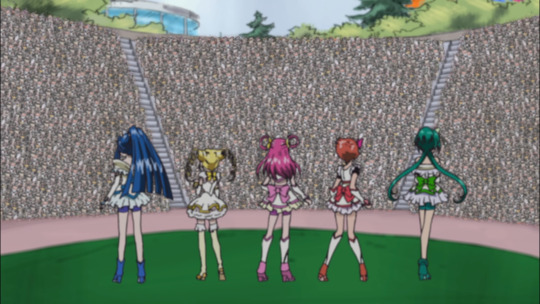
When did this become the Precure stage show?
As I indicated in the last review, this is one of those episodes that just really sticks out in my memory, but it turns out I don’t actually remember much about it at all. It’s not as impactful as I recalled, but it represents a step forward for Urara and it has a kickass fight. Let’s get started!
The Plot
Urara has been tapped to host a stage show at an amusement park, which is a big break in her career. She meets her friends at the park, along with her overly prepared manager Washio and Masuko Mika, who’s there to write about her for the paper. Mika and Washio hit it off right away, speculating about where Urara’s career could go from here, culminating in a Hollywood movie and an Oscar nod.
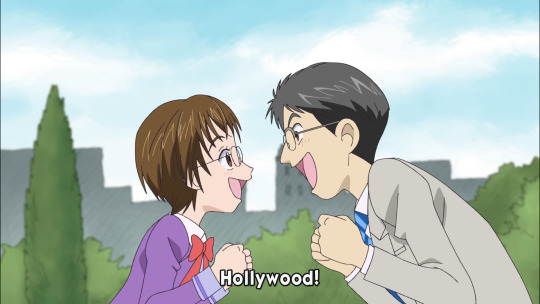
Urara arrives at her rehearsal, goes through wardrobe, and starts going through her routine. Unfortunately the star of the show has had an emergency and called out. Nozomi quickly volunteers to play her part in the show, to save Urara’s debut. Unfortunately, she isn’t a very good actress, but it’s too late to cancel the show now. Outside, we see Girinma handing out fliers for the show and making ominous remarks about its content....
At showtime, the stadium is filled with children and their parents, wanting to see the forest animals show. Nozomi is extremely nervous, despite Urara’s reassurance, and trips and falls during her entrance.
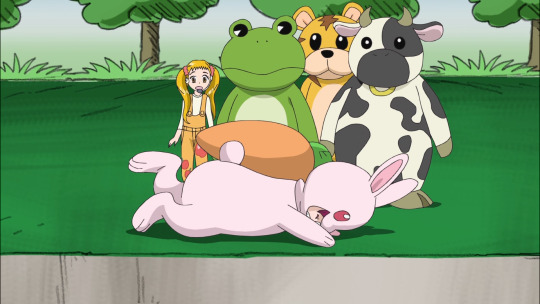
Before she can recover, Girinma drops a mask onto a prop tree, which turns into a giant Kowaina. Out in the crowd, Mika is confused by this strange story direction but the audience all thinks it’s part of the show. (no magical falling asleep here!) Rin, Karen, and Komachi all rush onto stage with Nozomi and Urara but aren’t sure if they should transform with all these people watching. However, Urara’s actor instincts kick in and she tells the audience to look at up just as Karen convinces the stage manager to turn on the spotlights, blinding the audience members momentarily. The girls seize their opportunity and transform into Precure. They fight the Kowaina as the opening theme starts playing, and it’s a very visually spectacular fight as they run, jump, and dive through tree branches and vines to try to land a few solid hits on the monster. It tries to shoot a leaf storm at the audience but Mint blocks it with her shield, and then Girinma tries to attack a nosy Mika, who is protected by Aqua. Dream manages to shoot off a Dream Attack, defeating the Kowaina, as Girinma retreats. There’s a gag during all of this where Washio is worried because he can’t see Urara, and somehow didn’t connect the dots when the five girls transformed on stage.
Mika, recognizing the Pretty Cures from her first meeting with them, takes lots of pictures of the battle and plans to write a piece about them. They’re sure that this time they’re busted, but once again Nuts runs interference, going up to her in his human state and saying hello. The next day at school, all the students are crowded around the newspaper again, and wouldn’t you know, it’s an expose on Nuts and Mika’s fated reunion, with a tiny article about Urara’s stage show at the bottom. Washio comes up and asks Urara to put on that show again, because the Precure fight was a smash hit with audiences, but the other four girls wave it off, and the episode ends.
The Analysis
I don’t know where to start. Urara is giving it her all in this stage show, and she even improvs a bit to keep their cover and distract the audience while they transform. She’s really good at what she does, and she has a promising future as an actor ahead of her. She presents a really energetic performance for the kids and tries to mitigate the danger by making it seem like the monster attack is part of the show. The show must go on, indeed! Additionally, when Nozomi steps up to play the part of the rabbit, despite fumbling in the costume and having trouble with her lines, Urara just rolls with it. I love that all the girls are really rooting for this to work out for her, and during the fight they defend the sanctity of the show and Urara’s part. And honestly, props to Nozomi as well. She’s trying her best here. She’s clumsy and has been kicked out of the drama club before, but her heart is in the right place, and there are no better options so the other three girls agree to help her with cue cards.
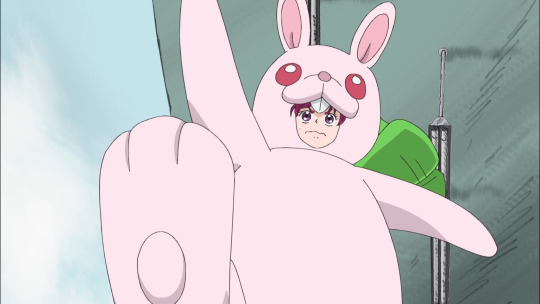
there’s a new kaiju in town
The battle itself is action-packed and filled with some dynamic scenes that I will turn into gifs. It’s one of the better fights in this show so far. I love how the girls fly around through the vines and branches, delivering some swift ass-kickings. There is some reused footage from the opening, namely the part where the five girls line up as the song counts off “One, two, three four five!” The kowaina makes itself a difficult target, despite its large size, and that keeps the battle interesting. It takes some work for the girls to actually get to the mask and break it. The large amount of civilians keep the stakes high, as they’re easy targets for a massive attack. This lets us see Mint use her shield in a more interesting way than normal (because I’ll be honest, a lot of the times she blocks the enemy’s attack when she could just dodge). I love getting to see her make use of her strengths. Shield cures are highly situational, but this was a situation in which it was very effective. Also, I liked how Mika’s insatiable lust for a scoop put her in danger. She won’t learn from it, but it’s an action that had nearly fatal consequences because Girinma was out for her head, and it took Aqua intervening to save her. When she did that, she referred to her by name, which might cause Mika to recognize them down the road... I don’t think so but we’ll find out.
Speaking of special attacks, there’s something I want to discuss about them. In the FW shows, the special attack was only ever used as a finisher. They never used Marble Screw or Twin Stream Splash to attack in the middle of a battle, but they do use their special attacks in Yes 5 as both attacks and finishers. Some of their attacks simply don’t work as finishers (I mean, I’d like to see them TRY to finish a monster off with Mint Protection, that’d be cool), and pink rules so you usually see Dream Attack used to take down the monster. What they don’t have is a clear group finisher. That will change, of course, but as long as this persists, I get a sense of inconsistency about what will and won’t destroy a Kowaina. The use of special attacks that aren’t finishers is a bit of a deviation from the original concept but it’s still tame here. I don’t think they ever go too far down this rabbit hole, but it’s worth noting.
This episode manages to mix in a good amount of comedy on the side, without overwhelming the main plot, and I admire the balance. Washio is a fun manager but he is really over-prepared. He appears carrying two giant duffle bags for Urara, despite the fact that her outfit is provided, and among the many things he has brought are some charms for....
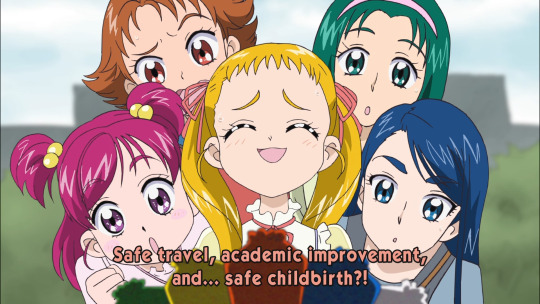
Nono Hana could use that last one
He and Mika play off of each other really well, they’ve got a nice comic relief duo schtick going on. Mika, of course, is mainly in this to get a good story for the paper, and having a local celebrity at school is a good outlet. Reporting on her career advancements is a big step up from reporting what she ate for lunch. Both of them readily buy into the fight scene, assuming it’s part of the show and not that there was some kind of actual danger, and Washio is just distressed that Urara has disappeared instead of fearing for his life. At the end of the episode, both of them ramp up the comedy in their own way. Mika’s crush on Nuts has not yet gotten old, and probably won’t for a while yet (don’t quote me on that), so continuing the running gag where she gets distracted from a big story by a chance (or intentional) encounter with him gets a thumbs up in my book. I don’t get tired of seeing Nozomi and Rin’s exasperated faces when they see her reports.
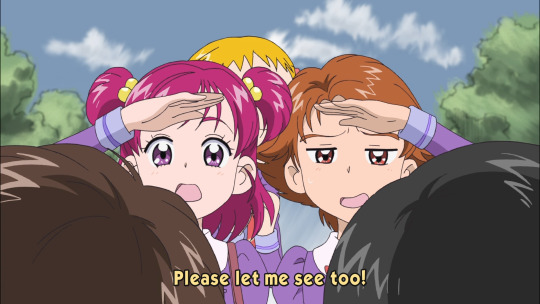
Also, Urara has a nice little gag there where she’s hopping up and down trying to read the paper because she can’t see over their shoulders. I’ll gif that soon.
Urara gets a couple of other moments of note, where she seems to be breaking the fourth wall. At the very start, when she’s sort of practicing her introductory speech to the crowd, she turns to speak to the show’s audience, and Rin questions who she’s even talking to. (Rin makes a good straight man, by the way).
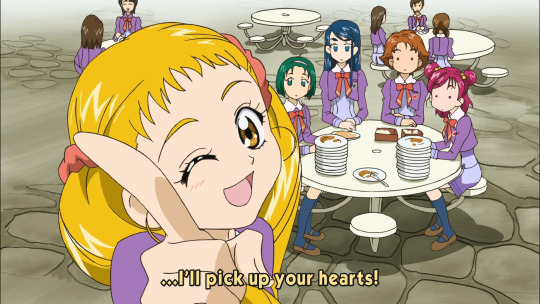
The last gag of note is when Coco and Nuts say they tagged along because you never know when a Pinky could show up.... and then a Pinky shows up right then. Yeah, Pinkies, remember them? They’re kind of supposed to be driving the plot. There’s more of them than there are Heartiels and Miracle Drops combined, yet they’re barely mentioned.
Just some other small observations before I wrap this up, I love everybody’s street clothes in this episode. They’re a little different from what we’ve seen them wearing before.
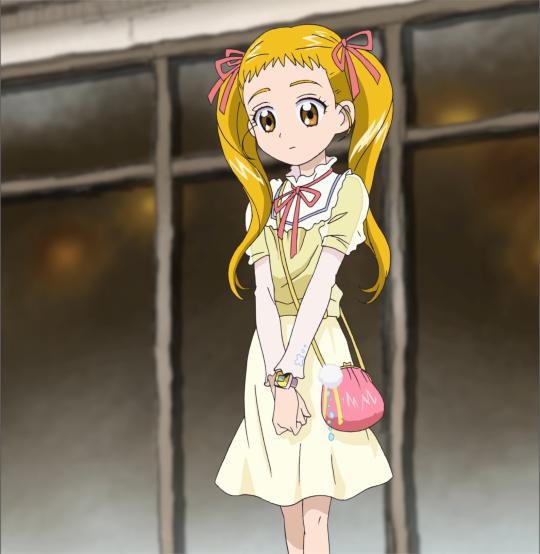
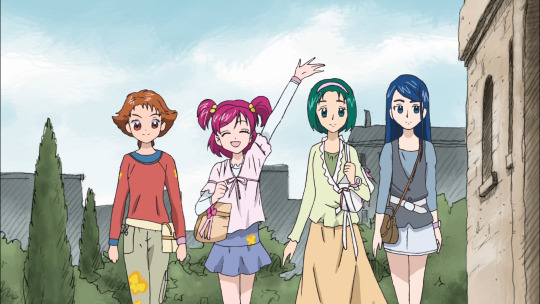
except for Rin
Urara’s sailor blouse and knee-length skirt make her look a little more mature than her normal attire of puffy shorts and sleeves. The other four are wearing outfits strongly reminiscent of their clothes from the ending. Rin and Nozomi’s outfits are exactly that, except for the butterflies. Komachi and Karen’s outfits are the same as what they wear in the ending, but the colors are a little different.

for reference
And for some reason the art in this episode is very hit-or-miss. A lot of good shots still seem slightly off model. It’s a little jarring, it’s not low-detail (except for one laughably bad frame), it’s just that faces are drawn with warped shapes. Yes I am going to chronicle every time this happens in every show, it’s notable.
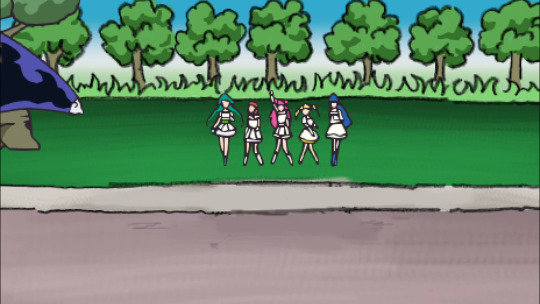
What happened here is that they quickly zoomed out to show the whole stage, and they wouldn’t need to show much detail, so to achieve the effect, they started way zoomed in on the cell before pulling back, rather than create a new drawing for one just frame. It’s not really visible when watching.
So, animation stuff aside.... this was a great episode! Since the major theme of this show is finding and chasing your dream, showing each girl’s different progress in that regard is important, and they do it so well. Urara is a bit further ahead than the others, but she still has a lot of work to do to become a famous actor, and her friends want to help her however possible. It’s what this show does best, and this was a fun stepping stone.
Next time, Rin is getting pulled in every direction at once! Look forward to it!
Pink Precure Catchphrase Count: 1 “kettei” by Nozomi herself, 1 each by Washio and Mika (spoken together)
NOTE: I’m going to come back to add some gifs to this post at a later date. I really wanted to include them the first time around but due to unforseen circumstances, this review was delayed several days past when I wanted to get it out, so I didn’t want to delay it any further. I’ll make a post on @pcd-status when I update this.
18 notes
·
View notes
Text
DBH Superhero AU
Ask and you shall receive! I'll give you guys the basic plot and main cast, but if you're interested I'll make a second post with the rest of the cast!
Enjoy (and sorry for no Read More, phone format is wack)
---
Plot:
In 2018, recently graduated bioengineer Elijah Kamski discovers an unknown hormone within an undiscovered species of deep sea jellyfish, while trying to find a cure for cancer. This hormone, dubbed Thirium, has the capacity to enhance the immunity system of a person, by making it impervious to most common illnesses and, after sufficient research has been done, can cure more exotic or aggressive diseases like malaria, rabies and Ebola.
After founding Hyperlife, a pharmaceutics company primarily focused on eradicating illnesses and evolving the human condition through genetic manipulation, Kamski makes it his mission to create a Thirium vaccine strong enough to not only prevent previously incurable diseases, but also completely change the lives of long-suffering victims of such illnesses.
He succeeds at first, but like with all success there is always a double-edged sword hanging just overhead.
Thirium, while good at changing human biology for the better, is also highly unstable and capable of mutating genes into something specialized and highly adaptable to certain situations. As such, after the T-Vaccine becomes a mandatory procedure, not only do people become healthy, but some select few exibit strange reactions to the added amount of hormones in their body.
These “Deviants” develop not only a stronger immune system, but also incredible abilities that, if not properly trained, could cause individuals to lose control and reek havoc.
Not only did the T-Vaccine have this unpredictable 10% chance of creating superhumans, but the mixing of Thirium with other illicit substances gave birth to a concoction known as Red Ice, a drug that could enhance the endurence and strength of a person temporarily at the expense of their mental faculties. If consumed for long periods of time, those addicted to Red Ice would exibit horrific mutations as well as behaviour degeneration, essentially devolving a person into something hostile and highly primordial.
As luck would have it, the black market for Thirium boomed, and Red Ice hit the streets like a flood, completely staining Hyperlife's reputation and forcing Elijah Kamski to abruptly give up power to his board of directors, before self-exiling himself outside of city limits to study Thirium and it's effects undisturbed.
Several years later, Hyperlife has risen in power through fear mongering anti-deviant propaganda, claiming that Detroit has become unsafe because of the 10% of people who have developed “inhuman” abilities. Deemed sub-human and unworthy of basic rights, Deviants have gone into hiding as soon as they begin exibiting strange abilities, living in fear of Hyperlife's most successful program, the Rook Division, which are three powerful bioweapons endowed with Deviant abilities, known only as Hyperlife's Hunters.
These Hunters cannot be reasoned with, respond only to their handler, and no one has ever seen their faces which are hidden behind thick helmets that ensure they can never go rogue.
It's in this hostile world where Jericho, a group of Deviant refugees, bands together to take back what Hyperlife has stolen from them: A right to live peacefully and unafraid.
Basic Info:
Hyperlife: Originally Elijah Kamski's well intentioned pharmaceutical company, Hyperlife has deviated from bettering the lives of people and become a tyrannical sub-government that has heavily contributed to the anti-deviant propaganda, as well as openly asking the public to contribute by outing suspected Deviants to the public so that they may be captured and sent to Hyperlife for “testing”. Lead by a shady board of directors, Hyperlife plans to harness the power hidden within the genes of Deviants to create powerful bioweapons, under a façade oficial creating a cure for Deviancy and the Red Ice pandemic.
Deviants: Humans who's genes were mutated by the T-Vaccine, causing them to develop extraordinary abilities. While Deviancy is a 10% chance of happening after taking the vaccine, it is still very unpredictable and hard to document. Deviants may not exibit changes immediately, and some carriers of the Thirium hormone might pass on Deviancy to their child instead. The only indicator of any biological differences is that a Deviant's blood becomes blue if exposed to a certain chemical, a test which is mandatory for every child ages 12 to 16 (The age gap in which a carrier's child might begin exibiting signs of Deviancy).
The Rook Division Hunters: The Rook Division's Hunters are a genetically modified subspecies of human, developed to harness several powers collected from captured Deviants.
The Hunters are completely conditioned to follow orders from Hyperlife through their handler, the strict Amanda Stern, and are incapable of feeling empathy for other creatures. Their primary focus is hunting Deviants, no matter what cost.
Their compliance is enforced by special designed uniforms, complete which thick helmets that not only hide their appearence, but completely separate them from the real world as well.
There are three confirmed RK Hunters, RK-51, RK-60 and RK-87. There are also several failed prototypes archived away in Hyperlife tower.
There are, however, rumors of a fourth much older MIA Hunter, which people claim was stolen by Elijah Kamski. Hyperlife has never confirmed these claims, and refrained from speaking of Kamski when asked.
Cast:
Markus Manfred/RK-20/Archangel: Elijah Kamski's most ambitious project and the predecessor of the Rook Division.
Markus was a ditch effort to correct Kamski's mistake with the T-Vaccine, by creating a virus through the usage of human genetic manipulation. The idea was that by testing on a human embryo donated by a host, plus genetic material from several Deviant donors, Kamski could acquire faster results that could show him a full erasure of the mutations from an individual's cells. Instead Kamski found himself with a healthy developing spliced embryo that exibited the power to copy and adapt to it's environment. Horrified with the implications of his actions, but fascinated by his new creation, Kamski fled from the city and sent Markus to his most trusted friend, Carl Manfred, before self-exiling himself. Deviant since birth and unaware of his true origins, Markus is none the wiser that he may not be entirely human.
Having been raised by Carl as if he were his biological son alongside Leo, has lead to Markus becoming a natural leader and overall caring by nature.
He is considered a Super-Adaptoid, who's primarily abilities are flight and energy beams projectiles. He can copy the abilities of others, but often tries to stick with his base powers since he can control them more easily.
His powers seem to have less drawbacks than most Deviants, with the exception of the occasional headaches and his healing factor reacting oddly to certain wounds (His skin pigmentation doesn't come back fully, leading to what appears to be vitiligo).
Note: He seems to secreet an alluring pheromone that helps him charm people, sadly this is not a conscious choice and Markus seems to be very self-conscious about it, often wondering if people care for what he has to say or if they're just compelled to agree because of this one oddity in his biology.
Simon and Daniel Lambert-Phillips/Titan and Behemoth: Twin brothers adopted by their godparents Caroline and John Phillips, after their biological parents died under mysterious circumstances. Simon and Daniel lived their early lives in the countryside before moving to the city to live with their adoptive parents and sister.
They are considered 2nd generation Deviants, since their parents were Carriers of the T-Vaccine mutation. As such, they began to notice something wasn't quite right when they hit puberty.
Unusually resilient to illnesses and overall stronger than most kids their age, Simon and Daniel didn't discover their abilities until much later which, considering they are Sizeshifters, was rather lucky for them. Capeable of shrinking to minute sizes or growing to monstrous heights, the twins are either the ideal reckon team, or the demolition team straight out of your nightmares.
It's wise not to get on their bad side, even if often times they are considered gentle Giants… Well at least Simon is.
Daniel's response to most problems seem to be smashing them with his fists, which doesn't really help his reputation in the slightest.
Note: Their powers are linked to their emotional states, which implies there is an increase or decrease of hormonal levels which causes them to either shrink or grow. It's advised they regularly meditate or practice other calming activities to avoid the acceleration of the heart or a surge of addrenaline. Their metabolism is also affected by their powers and it's essential for them to consume large amounts of high calory foods after growing to sizes between 30 and 50 feet of height.
North Kelly/Northstar: Another 2nd Generation Deviant, North is a temperamental girl with a past full of anguish. Orphaned at a young age due to Hyperlife's hunt for Deviants, North was passed around the foster care system like a worthless doll. Suffering abuse from foster parents and uncaring staff members alike, North finally put her foot down and ran away when she turned 18.
Not too long after her escape, she discovered that she had super strength, which she quickly put to good use by becoming a vigilante. Known for attacking those who attempted to assault defenceless girls out in the streets late at night, the Northstar is a name passed down by those she has saved, and those she has punished as well.
How such a notorious Deviant ended up at Jericho, only Simon and Josh seem to know, but North certainly seems to want to help make more of a change than just hunt perverts during the night…
Note: North's powers have affected her physical appearence ever so slightly, so it's advised that she wear larger clothes to hide the unusual amount of muscle mass. Meditation classes have also been advised to help control her temper, an option she has chosen to ignore in favour of practicing judo and kickboxing.
Josh Sawyer/Technobabble: Like most members of Jericho, Josh is a 2nd generation Deviant who gained his powers through his parents. Highly intelligent and in complete control of his abilities, Josh is a valued member of the team who usually holds the fort while the others go on missions.
A powerful technokinetic who provides all gear for his teammates (including the specialized suits Simon and Daniel need when using their powers), Josh has absolute control of all tech within Jericho, and can easily interface with any electronics he's near.
Note: Seems to suffer frequent migraines if he uses his power for extended periods of time. He doesn't talk much about his parents and seems to be living with his aunty Rose and Cousin Adam Chapman.
RK-51/Connor Anderson: Hyperlife's first successful Hunter, RK-51 is a powerful bioweapons engineered from harvested Deviant genes and DNA “donated” by the deceased Cole Anderson. Originally ruthless and unfeeling, RK-51 seems to have slowly began deviating from his conditioning after he was wounded by Markus in a fight. With his helmet broken and zero contact with Hyperlife, the Hunter expected to die out in the frigid roads, until one Hank Anderson came upon him and rescued him.
Unsure of where he belongs in the world, RK-51 is slowly learning to overcome his past as a Hunter and slowly becoming who he truly wishes to be: Connor.
Like Markus, Connor is a super-adaptoid, and can absorb the powers of others like a sponge. His primary abilities are flight and ice/water manipulation, which he was trained to control better.
Note: His temperature is unusually low due to his affinity for ice powers. He is very curious by nature and seems to be genuinely caring of others's well being. He has grown attached to Hank due to the old cop treating him like a person rather than a weapon. He likes dogs!
RK-60: Hyperlife's second successful Hunter, RK-60 is slightly more aggressive than his predecessor and seems to take pleasure in hunting down his targets. Unwilling to defy Hyperlife and Amanda's will out of fear, RK-60 hides behind a cocky facade when put on the spot.
A super-adaptoid who's primary abilities are super speed and fire manipulation, RK-60 is a hot-head and starved for praise.
Note: Like RK-51, his temperature seems to run unusually hot due to his powers. He won't admit to wishing for freedom due to being absolutely terrified of Amanda and failure in general. He envies RK-51 for having somehow managed to escape.
RK-87: The third and final successful Hunter, Rk-87 is the perfected version of both RK-51 and a RK-60. Taller, faster, stronger and more intelligent than both his predecessors, RK-87 is the most perfect bioweapon Hyperlife has ever created.
A super-adaptoid who favours flight and super strength.
Note: Has been plotting over how to escape Hyperlife's clutches, as well as rescue all captive Deviants and Hunter Prototypes. Cunning like a fox and too intelligent to contain, but willing to play along until the moment is right. Seems to be find of his predecessors.
30 notes
·
View notes
Text
16 Talented Artisans That Deserve Your Undivided Attention
16 Talented Artisans That Deserve Your Undivided Attention
TDF Design Awards
by Lucy Feagins, Editor

Lucy Tolan pieces. Photography – Shelley Horan. Art Direction and Styling – Both.

Alison Frith ceramics plinth. Photo – Tania Bahr-Vollrath.
Lucy Tolan, Seams
The objective of Seams by ceramicist Lucy Tolan was to investigate technique and form through the construction and deconstruction of the vessel. The body of work explores the textile qualities of clay and convergence of materials through accentuated joins – seams.
See our feature on Lucy’s practice here.
Alison Frith, Ceramic Plinth
Inspired by the need for function yet the desire for considered design, Alison Frith created the Ceramic Plinth. Made entirely by hand, each plinth is wheel thrown, with composite pieces formed and joined together.
Precise attention was paid to weight and form to ensure the final piece could serves as a functional side table or a standalone sculptural object.

Georgina Proud ceramics. Photo – Georgina Proud.

Eun Ceramics. Right photo – Isabella King. Left photo – Jess Brohier.
Georgina Proud, Flotsam//Jetsam
Flotsam//Jetsam is a collection of clay vessels featuring embedded materials to create unique and distinct surfaces. In making the collection, ceramic artist Georgina Proud experimented with materials found on beaches throughout Victoria such as pebbles and sea glass, and investigated how these react to the ceramic process.
Eun Ceramics, Curved
Eun Ceramics’ Curved collective is an observation on societal norms. Irregular curves meeting the narrow neck opening, representing our individuality being suppressed or shaped to fit a status quo.
The unique style of ceramicist Jess Choi means each angle carries a different form and texture, creating new perspectives in the unusual clay bodies.
See our feature on Jess’ practice here.

Oh Hey Grace ceramics. Photo – Jess Brohier.
Oh Hey Grace, A Place To Call Home
A Place to Call Home is a collection of sculptures made from mid-fire glazed ceramics using a combination of sculpting, hand-building and wheel throwing by ceramicist Grace Brown. Sculpted utopian cityscapes and dwellings were developed in response to the often dystopian reality outside, particularly during 2020-21.
See our feature on Oh Hey Grace here.

Hamish Munro rings. Photo – Peter Ryle.

Left: Bioregional Rings by Kyoko Hahimoto. Photo – Kyoko Hashimoto. Right: Bioplastic Vessels by Jessie French. Photo – Pier Carthew. Art Director – Thalia Economo.
Hamish Munro, The Joan Series
The Joan Series by jeweller Hamish Munro consists of interchangeable, genderless rings designed around the precise geometry and angled position of individual stones. Pieces explore the removal of surface area within the ring, instead ‘subtracting’ from the classic form of a band and creating a dynamism between stones.
This collection represents a deviation and expansion on Hamish’s previous jewellery pieces as he broadens his experience with technique, process and familiarity with stone.
See our feature on Hamish’s practice here.
Kyoko Hashimoto, Bioregional Rings
This series of rings by Kyoko Hashimoto presents materials that can be found and processed locally in Sydney Basin bioregion. Raw materials include Hawkesbury sandstone conglomerated in the earth 250 million years ago, and coal from the Illawarra Coal Measures that formed in geological strata several kilometres deep below the sandstone.
The body of work intends to define a region by its environment and earthly yield rather than the borders imposed by humankind.
Other Matter, Algae Bioplastic Vessels
Tempering aesthetic beauty with future thinking, Other Matter has generated a collection of bioplastic tableware made using algae polymers and pigments. These aesthetically striking pieces reminiscent of glass are recyclable, biodegradable, and can be composted in a home system.
Other Matter is the studio founded by artist Jessie French. Her solo practice explores speculative futures and material boundaries through work with algae-based bioplastics. Her research into seaweed supply chains has taken her from artist residencies in Morocco to group shows in New York City.
See our feature on Jessie’s practice here.
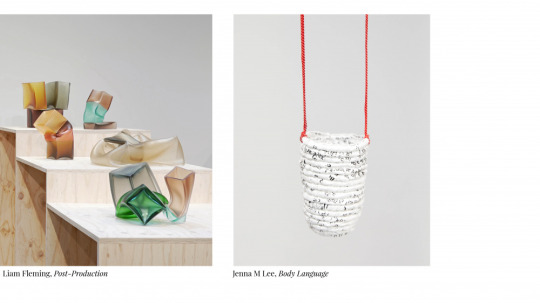
Left: Liam Fleming glass. Photo – Josephine Briginshaw. Right: Jenna M Lee works. Photo – Henry Trumble.
Liam Fleming, Post-Production
Glassworker Liam Fleming’s practice combines mould-blowing and cold lamination. In Post-Production, he subjects objects to a rough surface treatment, fusing them at high temperatures in a kiln, then joining them in a manner at odds with the precision of cold lamination. The glass slumps and warps, collapsing under its weight and expanding with pressure.
The body of work was created as part of ‘Preliminary Strcutures’, a group show of seven designers curated for Melbourne Design Week 2021. The makers represented contemporary glass and ceramic work, displaying non-traditional and interpretive structures for their media.
Jenna M Lee, Body Language
Jenna M Lee is an artist and graphic designer living in Melbourne, whose highly symbolic work seeks to reclaim agency over the historic representation of Aboriginal people in Australia.
Using pages from the colonial text ‘Aboriginal Words and Place Names’, the artist created three dilly bags embellished with red silk thread and glass beads. The paper-based pieces in the Body Language series explore the relationships between cultural objects and adornments as an extension of the body; the body itself as an extension of Country and language; and Country, language and body as elemental factors of connection and healing.
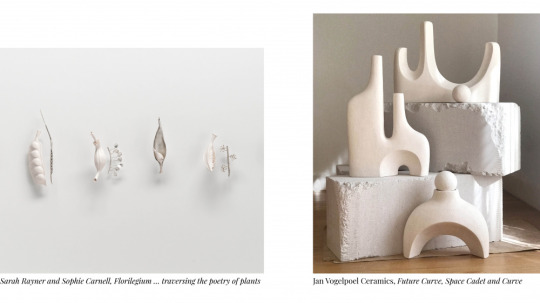
Left: Sarah Rayner + Sophie Carnell works. Photo – Greg Piper. Right: Jan Vogelpoel ceramics. Photo – Jan Vogelpoel.
Sarah Rayner + Sophie Carnell, Florilegium
Porcelain artist Sarah Rayner and silversmith Sophie Carnell collaborated to create 42 small handcrafted sculptural works inspired by the complexity and richness of native flora. The duo’s chosen materials of porcelain and silver have been morphed from inert matter into 3D works.
Initially driven by a passion for the natural environment and the process of collection, the pieces en masse represent the poetry of flowers. The series is tactile, sensual and compelling.
Jan Vogelpoel Ceramics, Future Curve, Space Cadet and Curve
These three ceramic pieces are inspired by the curves of the Glebe House designed by Chenchow Little, and the Taal monument designed by Jan van Wijk. Restrained forms allow the form, curves and clay to work their magic without overworking or overthinking the design or the process.
Jan Vogelpoel‘s forms are undulating, organic and honest.
See our feature on Jan’s practice here.

Left: Photo – Polly Wright. Right: Photo – Ferro Forma Studio.
Erin.k jewellery + Koorie Tales, Source of Life + Essence at Dusk
Jewellery label erin.k jewellery created two collections featuring artist Holly McLennan-Brown of Koorie Tales’ artwork. Pieces convey elements of Holly’s Yorta Yorta culture, with the intent of making Indigenous art more accessible.
5% of sales from pieces in the collection are donated to Koorie Heritage Trust.
Alison Jackson & Dan Lorrimer, Flow Form Vases
Flow Form Vases by Alison Jackson and Dan Lorrimer (now Ferro Forma studio) blend small-scale metalsmithing production techniques with one-of-a-kind artwork processes to create a series of unique tableware objects. Complex hydraulic pressing tools allow the initial tubular form (in either brass or stainless steel) to be pressed repeatedly along its length, each time changing the surface.
Once formed, a multi-step finishing sequence layers the surface of each piece with a unique patina.
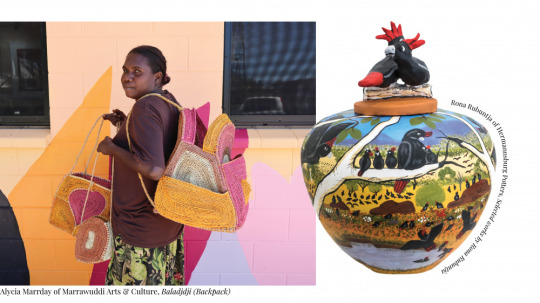
Left: Artist Alycia Marrday with her work. Photo – Marrawuddi Arts & Culture. Right: Erraarnta (red-tailed black cockatoo) by Rona Rubuntja of the Hermannsburg Potters. Photo – Hermannsburg Potters.
Alycia Marrday of Marrawuddi Arts & Culture, Baladjdji (Backpack)
Artist Alycia Marrday independently created this woven backpack with the support of community arts centre Marrawuddi Arts & Culture. Combining both ancient and traditional methods, the large and bright piece is an example of phenomenal weaving mastery. All materials are natural including Kunngobarn (pandanus) and Kala (natural dye) collected on Country.
Alycia says: ‘Maybe my kids give me idea, Anita. My kids really love the backpacks weavings. I look at the backpacks my kids have and try weave same pockets. I just used it from my own mind, I get the kala (colour) from my partner’s homeland.’
Rona Rubuntja of Hermannsburg Potters, Selected Works
Rona Rubuntja of the Hermannsburg Potters’ joyous style is distinctive, humorous and imaginative. Rona is a deaf and non-verbal person, and uses the medium of pottery to tell stories of her life. Each of these works emanate joy while depicting contemporary life in Ntaria (Hermannsburg community) and speaking to Western Aranda values.
The Hermannsburg Potters are an artist collective established in 1992 and has grown to nearly 20 artists. The artists paint stories of the surrounding Country, community, animals and memories of family onto the surface of their hand-built terracotta pots, topping each piece with a figurative sculpture. The works are vibrant, cheeky, purposeful and original, displaying a deep knowledge of Country, and a playful, vivid view of contemporary desert life.
See our feature on the Hermannsburg Potters here.
1 note
·
View note